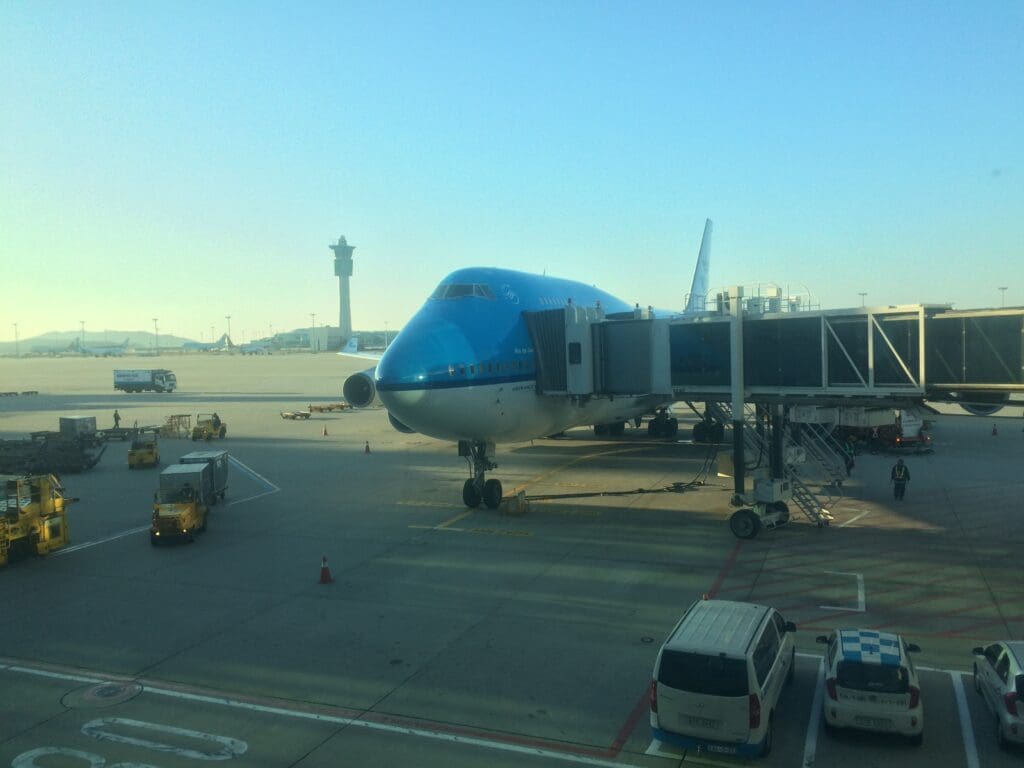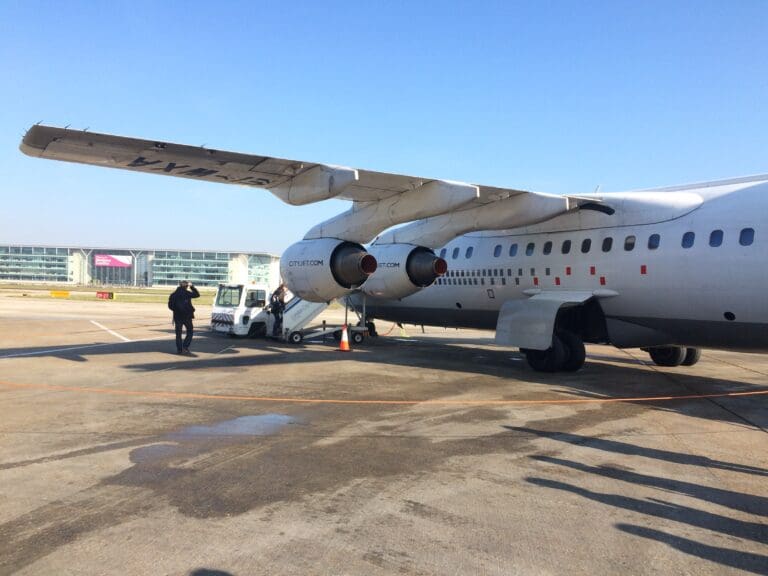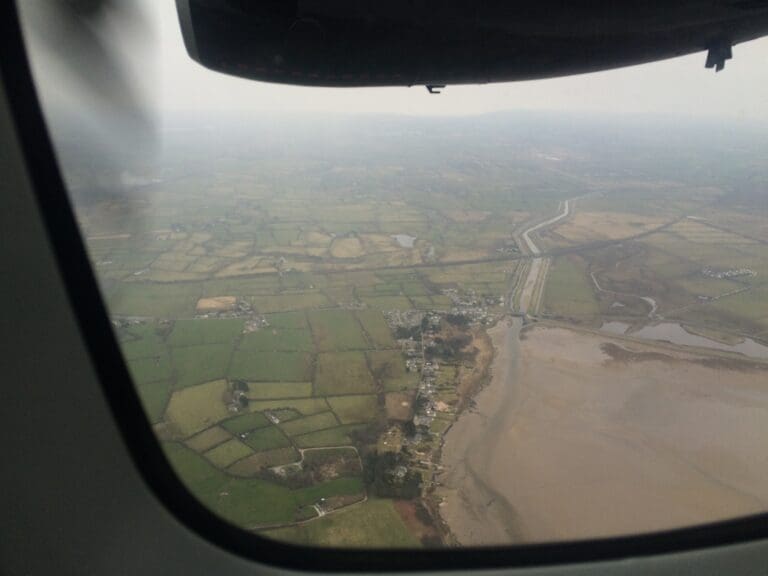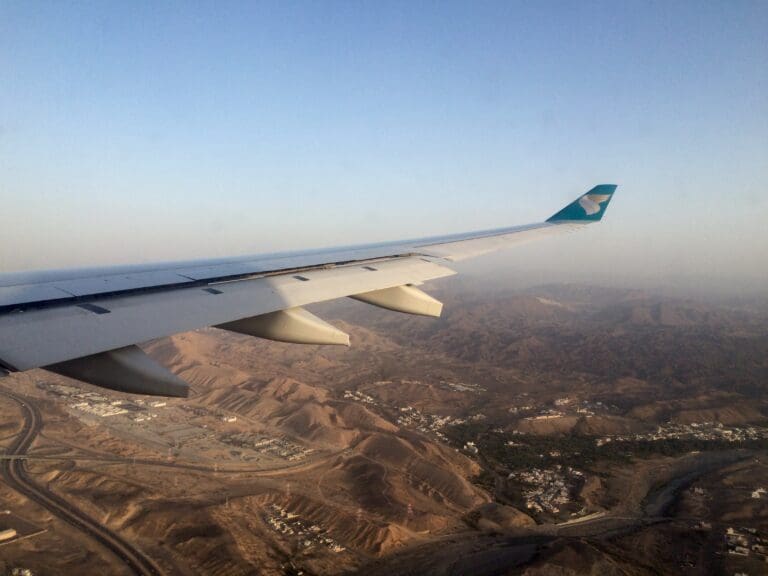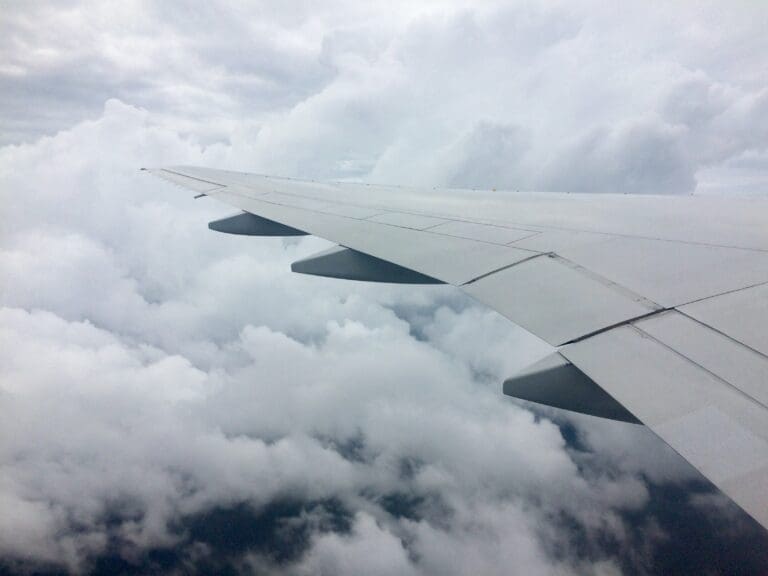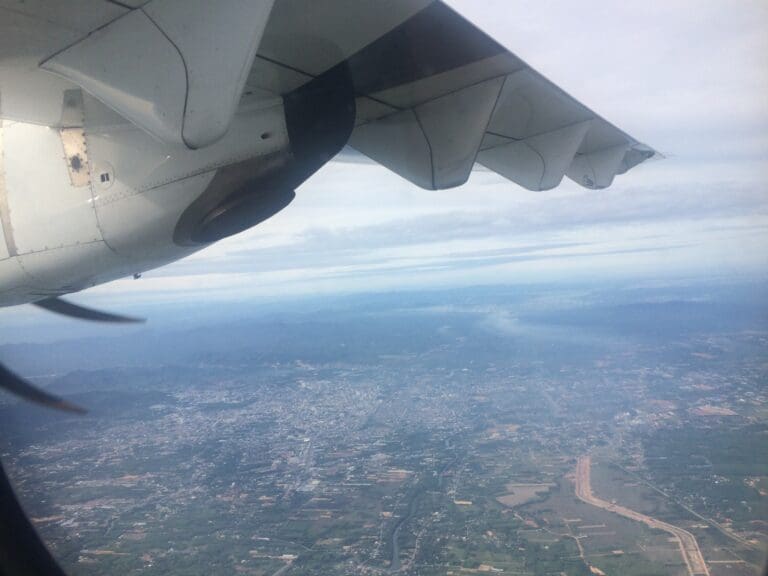KLM Classics: Humberside to Seoul Incheon on a Fokker 70 and a Boeing 747 Combi
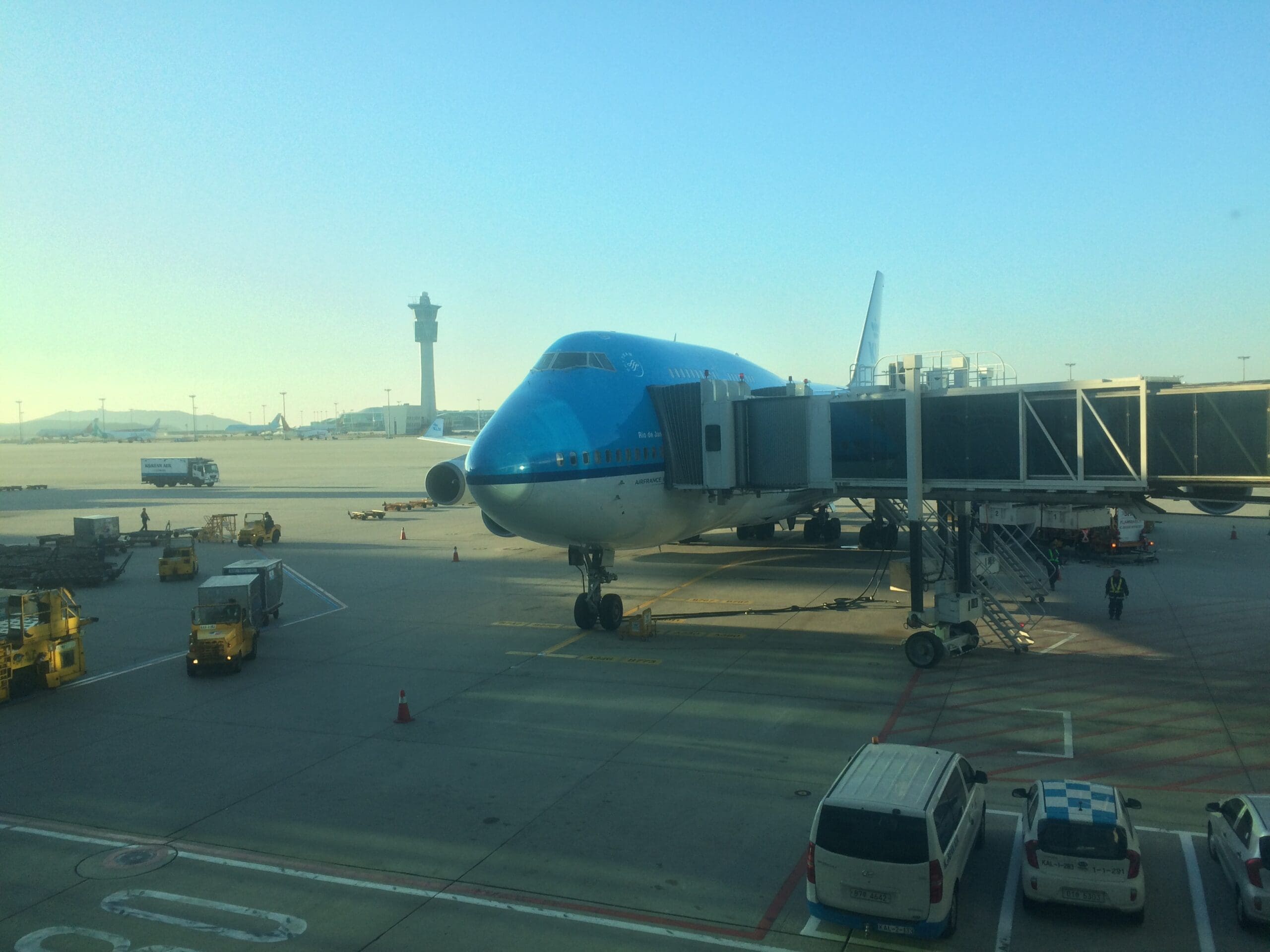
You can read all the background and booking information in my report on Korean Air’s Airbus A380.
Following a week spent visiting my family in Sheffield, the time had come for me to return back to Korea. Much to my delight, for the duration of my stay the weather had decided to take a break from being British and I found myself journeying to Humberside Airport under gloriously sunny skies. After around an hour and twenty minutes in the car, I arrived at the airport where I was met by the sight of a noisy Royal Air Force Airbus A400 undertaking circuits. Humberside Airport is far from the largest in the UK, with this being the 34th busiest in the UK (in terms of passenger traffic) as per the latest statistics at the time of my flight. Located just to the south of The Humber, on the opposite side of this to the city of Hull, the North Sea oil and gas industry can be thanked for the airport’s commercial operations. Today, Humberside Airport is served by Eastern Airways, KLM Cityhopper and Sun-Air of Scandinavia who operate services to Aalborg, Aberdeen, Amsterdam and Billund, whilst a near constant stream of helicopters fly workers to and from offshore platforms for much of the day.
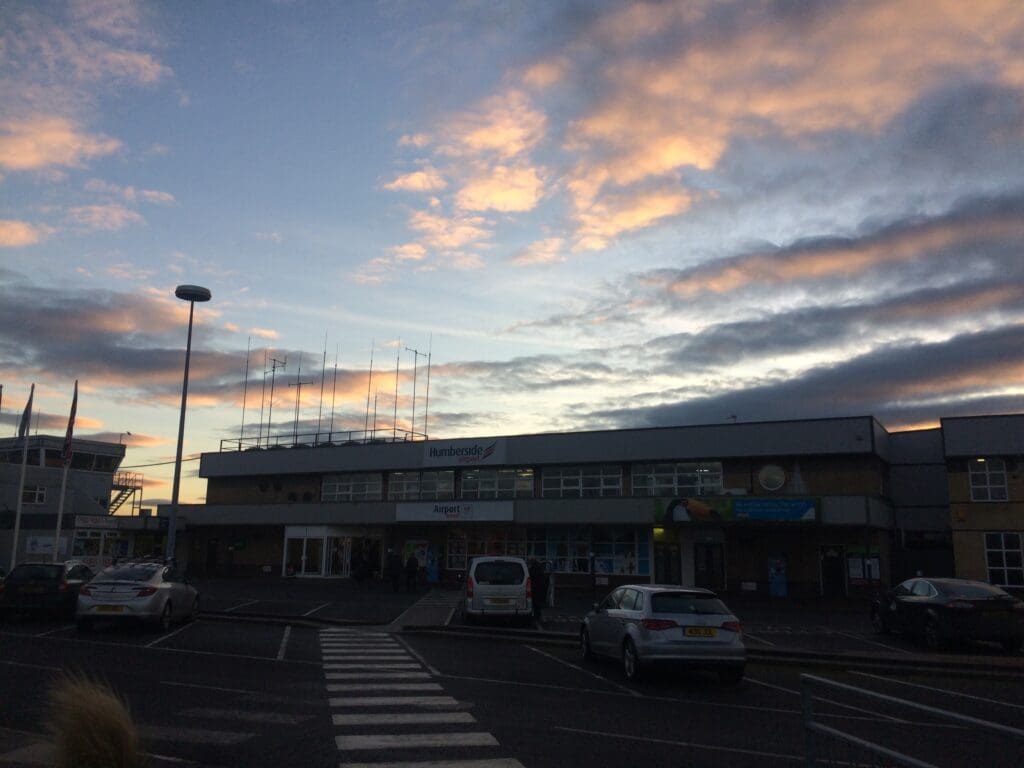
With two flights departing, once inside the small check-in hall I found this to be a little busy although I was able to make it to one of KLM’s check-in desks fairly quickly and was served by a very friendly and helpful check-in agent. Once I had parted with my hold luggage and received my boarding passes for the two flights to Korea, I joined the security line. With just one checkpoint open, this was fairly long and moved along relatively slowly and it took around twenty minutes to make it through to the airside portion of the terminal. After passing through security, I made my way past the terminal’s small duty free shop and headed into the airside departure lounge which I found to be nice and comfortable, with plenty of space and lots of sofas. For those wishing to grab something to eat or drink prior to their flight, a café-bar is on hand although I decided to pass on this and took a seat and surfed the internet as I waited for boarding to commence.
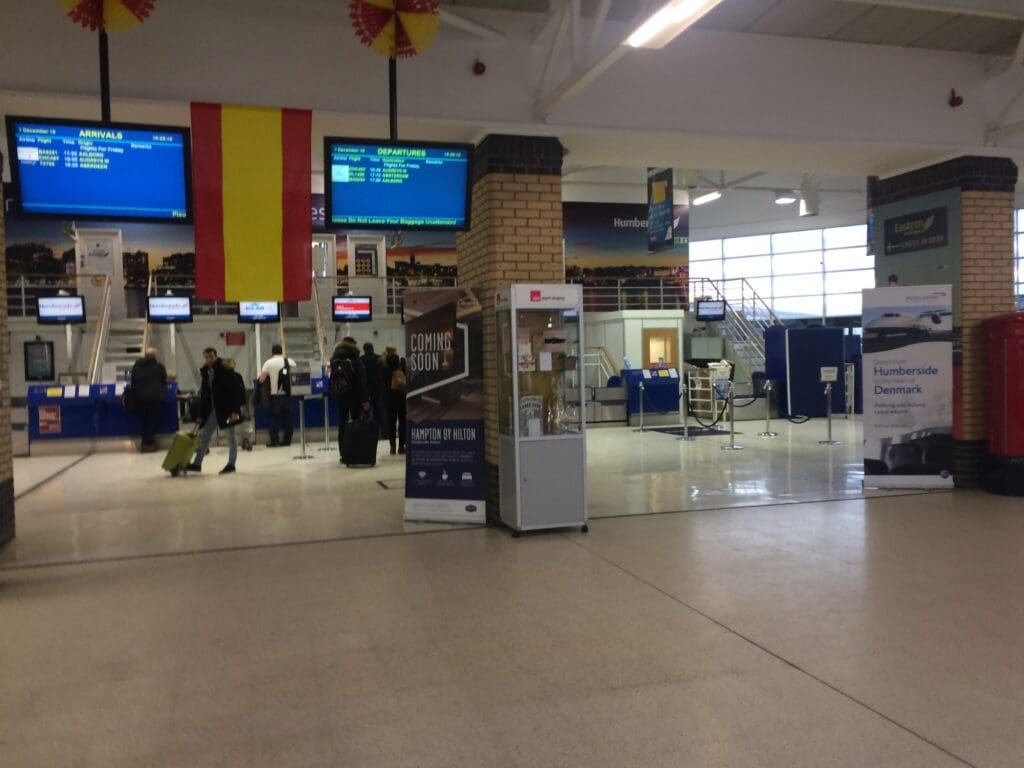
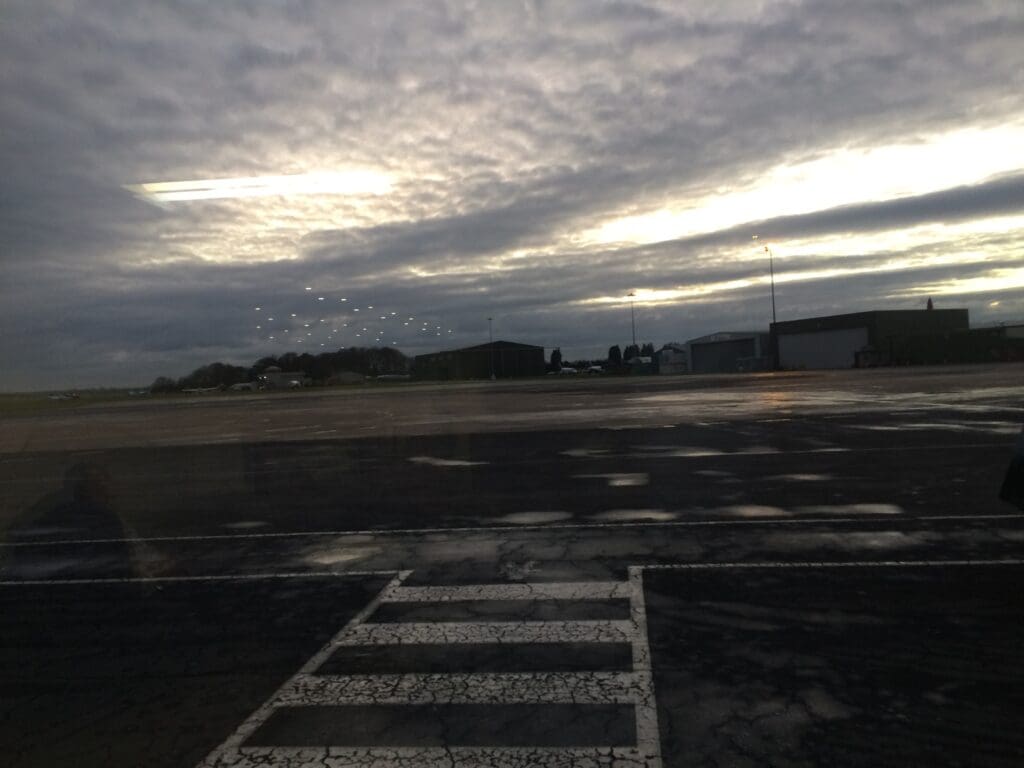
As time passed, more and more passengers for the Amsterdam service arrived in the departures hall, with most passengers appearing to take the form of suited business people – many of whom seemed to hail from Denmark and Norway and were presumably just connecting in Amsterdam. Following a short flight over from the Dutch capital, the Fokker that would be taking us across the North Sea could be seen pulling into gate 4 slightly behind schedule. This aircraft took the form of PH-KZS, which was manufactured at Fokker’s Schiphol facility and first took to the skies in April 1995 making it around 21.5 years old at the time of my flight. This jet started its life with French carrier Air Littoral as F-GLIS before being passed on to Air France’s regional subsidiary Régional in late 2003. In August 2009, the aircraft was transferred over to KLM Cityhopper where it has remained ever since. During its time with KLM Cityhopper, the aircraft appears to have been involved in one notable incident which involved a hydraulic problem at Schiphol in August 2014. In the week prior to my flight the aircraft had connected Amsterdam Schiphol with Aalborg, Belfast, Billund, Brussels, Cardiff, Dusseldorf, Frankfurt, Hannover, Humberside, London Heathrow, Munich, Norwich, Southampton, Stavanger, Teesside and Zurich.
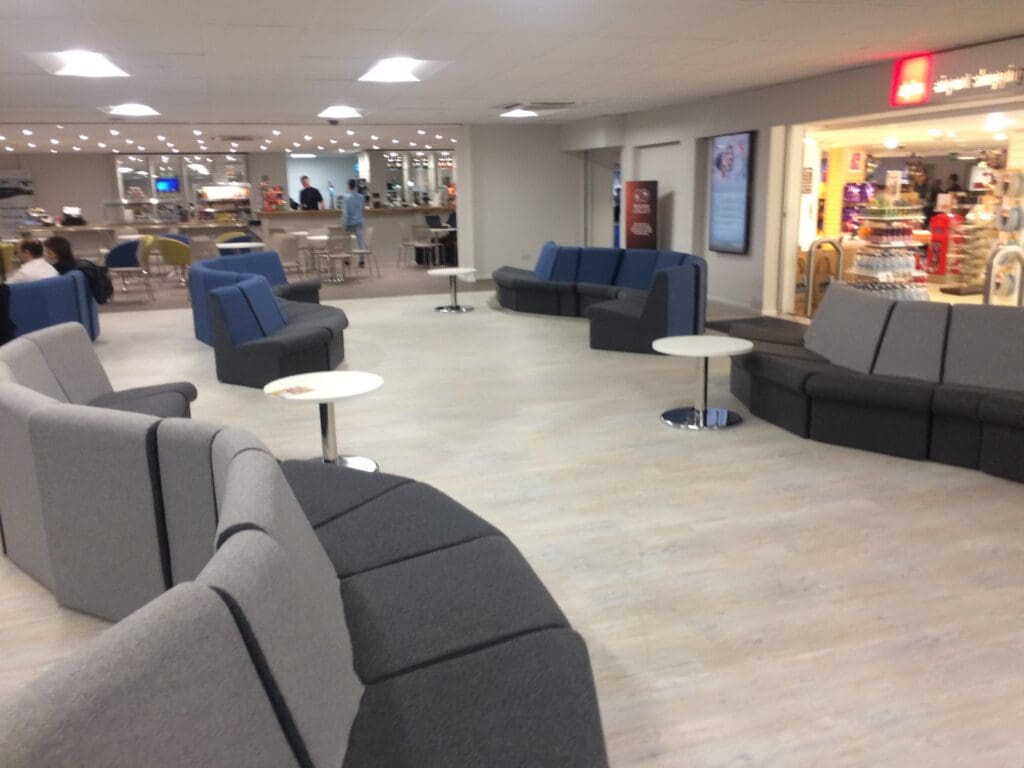

Around sixteen minutes after the aircraft arrived in Humberside, at 1700 boarding was called with priority passengers, of which there appeared to be many, invited to head out to the aircraft first. Eventually, all ‘regular’ passengers were invited to board and I soon had my boarding pass scanned by a rather stern looking Swissport agent before I made my way out into the chilly winter evening air. Following a quick walk across the apron, I climbed up the Fokker 70’s built-in steps and soon received a very friendly welcome by one of the two cabin crew members working the flight over to Amsterdam. With KLM Cityhopper maintaining crew bases in Humberside, Leeds Bradford and Norwich, I was not overly surprised to find that both cabin crew members appeared to hail from the UK whilst the pilots up front were both Dutch.
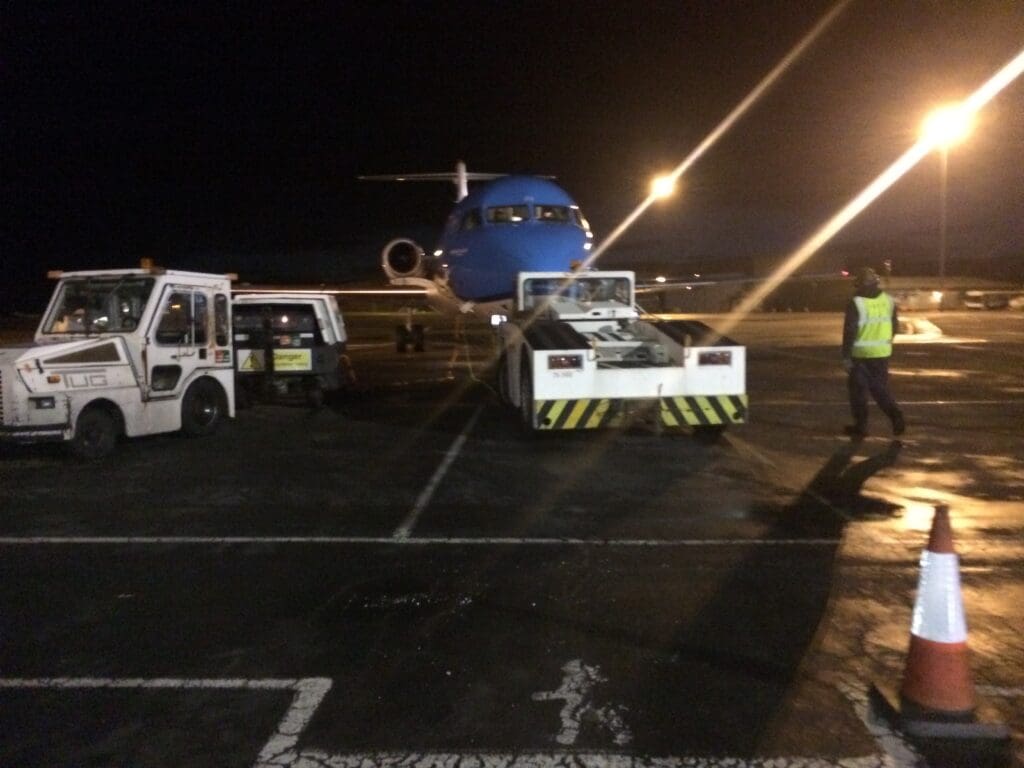
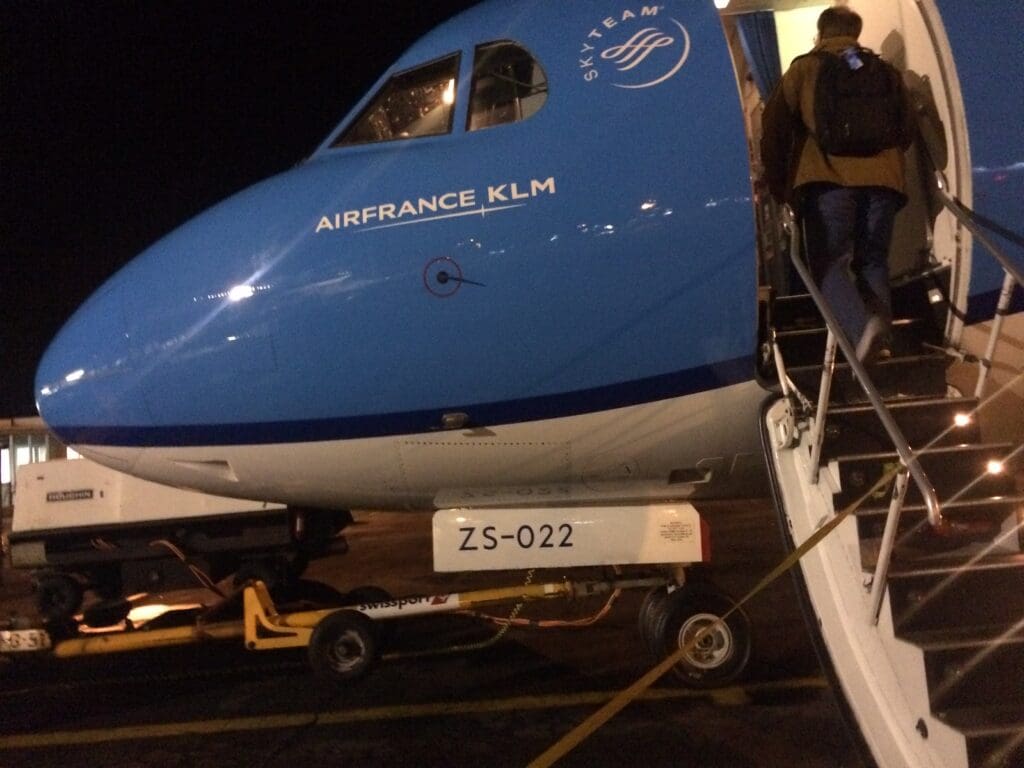

As I made my way down the aircraft, I found the cabin to appear to be in a spotless condition and fairly modern thanks to the new slimline seats, with my only complaint at this stage being the cabin’s sauna-like temperatures. Soon making it to my seat at the rear of the aircraft, I sat down and settled in for the short flight ahead. In terms of comfort, I found the seat to be comfortable and offer a decent amount of legroom, especially for a regional aircraft. That evening, the flight appeared to be completely full and I failed to spot any empty seats. At 1730, twenty minutes after our scheduled departure time, one of the cabin crew members performed their welcome announcement and a short time later the two Rolls-Royce Tay 620-15 engines noisily fired up into life as we were pushed back from the stand.
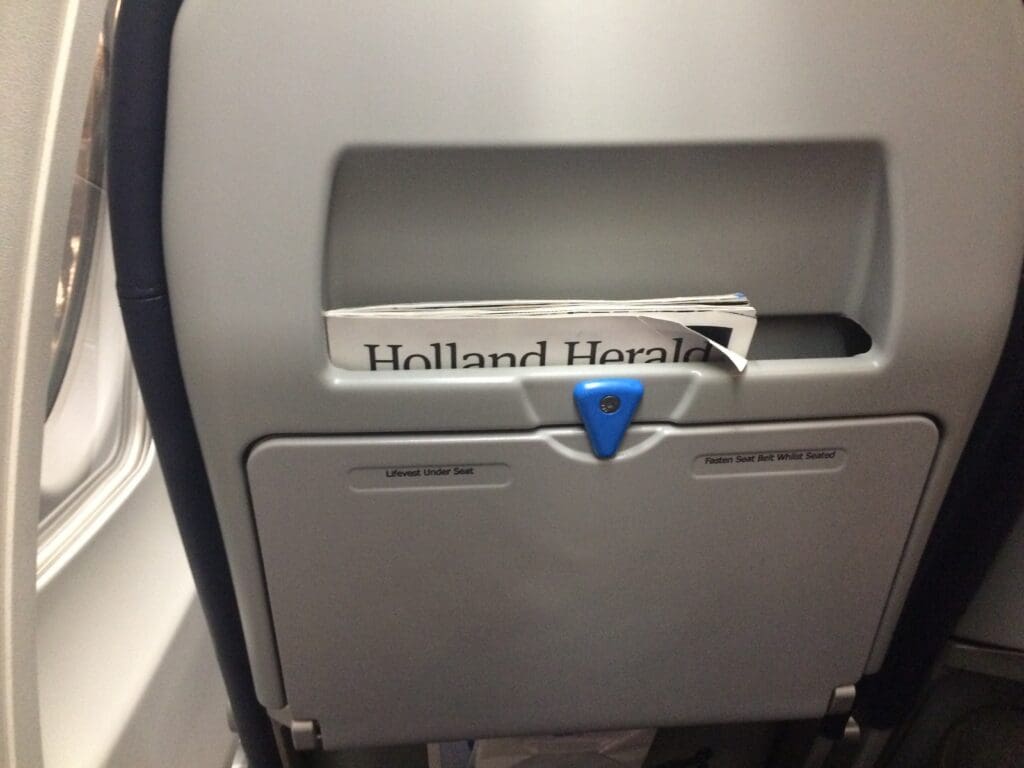
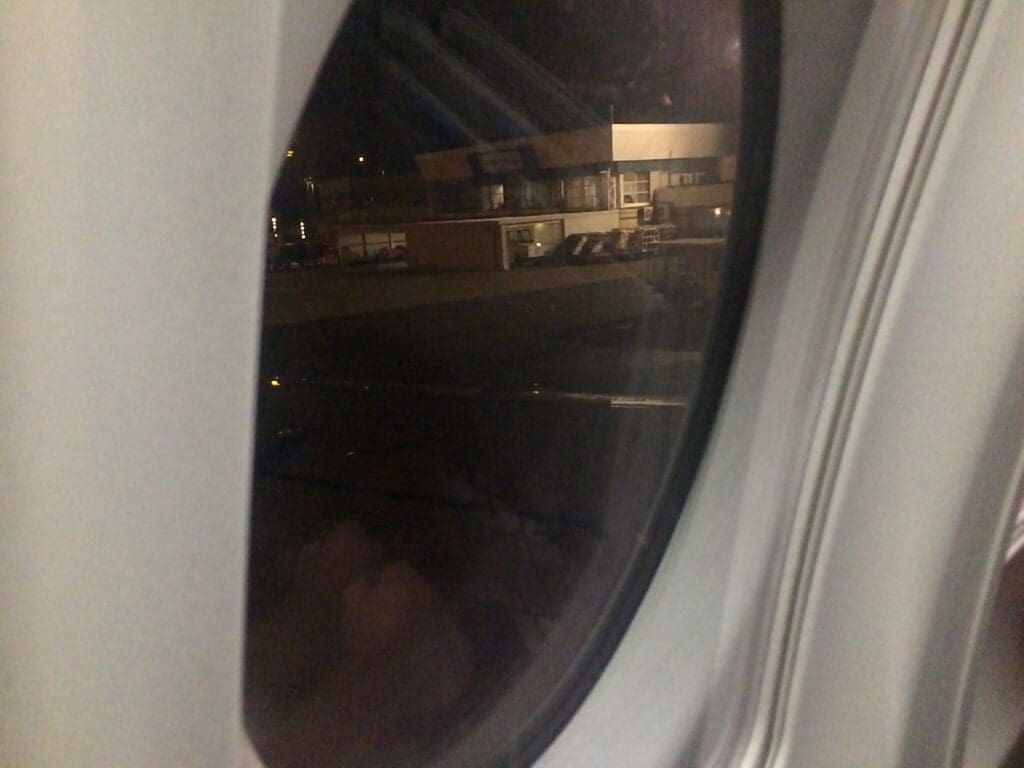

With Humberside Airport not covering a particularly large area, it didn’t take too long to reach the runway and we taxied onto this without holding before backtracking down this before performing a powerful takeoff and rocketing upwards into the night skies. Once up in the air, the Fokker turned eastwards and soon left the Lincolnshire coastline behind. As we climbed the captain gave a short speech with the usual information regarding our flight and service began. This consisted of half an egg and cress sandwich, a biscuit and a sealed container of water, whilst a drinks service followed once all boxes had been distributed.


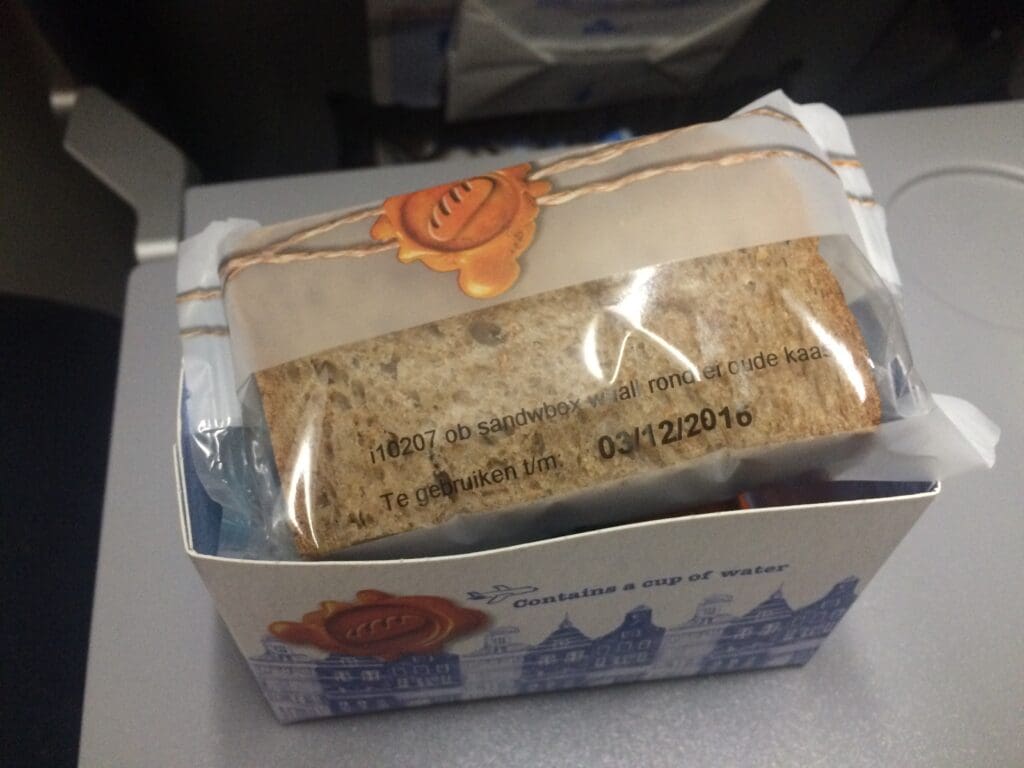
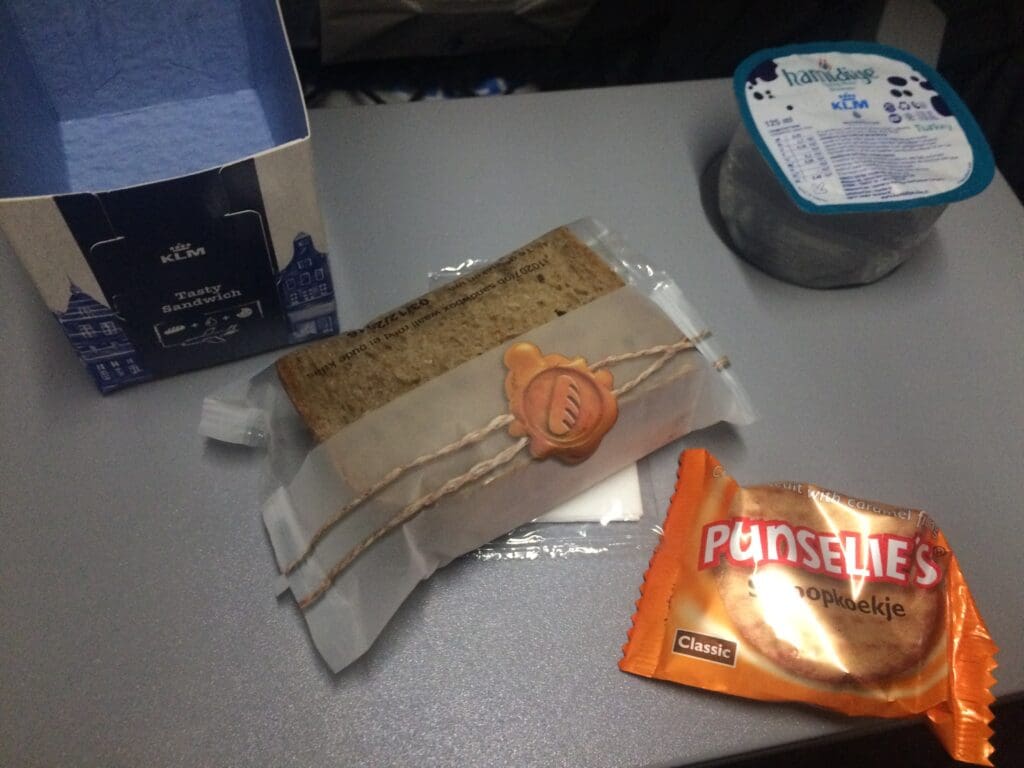
Cruising over the North Sea, that evening the flight was smooth and before I knew it the captain’s voice came over the speakers advising that we would very shortly commence our descent. A minute or so later the Fokker could be felt sinking towards earth and soon enough we touched down in Amsterdam. Whilst the captain had advised that we would have a short taxi, it took us about 10 minutes to reach our stand in the Fokker/Embraer farm, although I suppose this is short by Amsterdam standards! Once at a stand, the engines spooled down immediately and with buses already waiting disembarkation commenced a very short time later. After thanking both the purser and the captain, I boarded the bus and was soon taken on a quick tour of the ramp before arriving at the terminal. Being my first visit to Schiphol in over nine years, the airport did not seem to be as nice or modern as I had remembered it with this being tired looking and a little dirty in places.
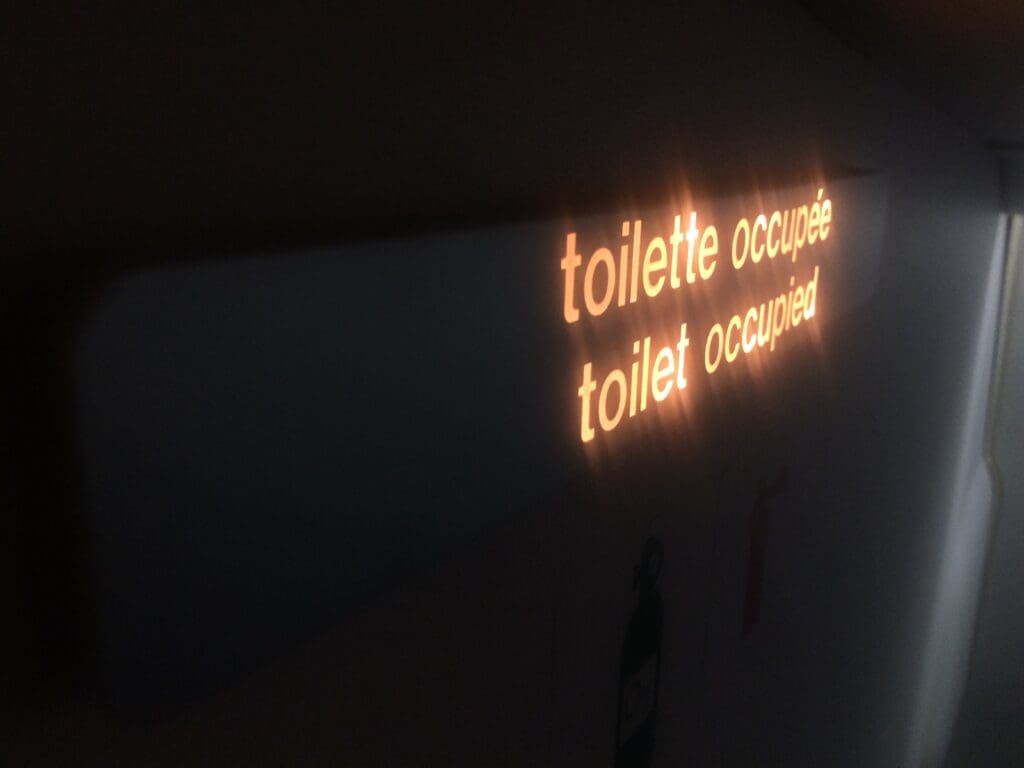
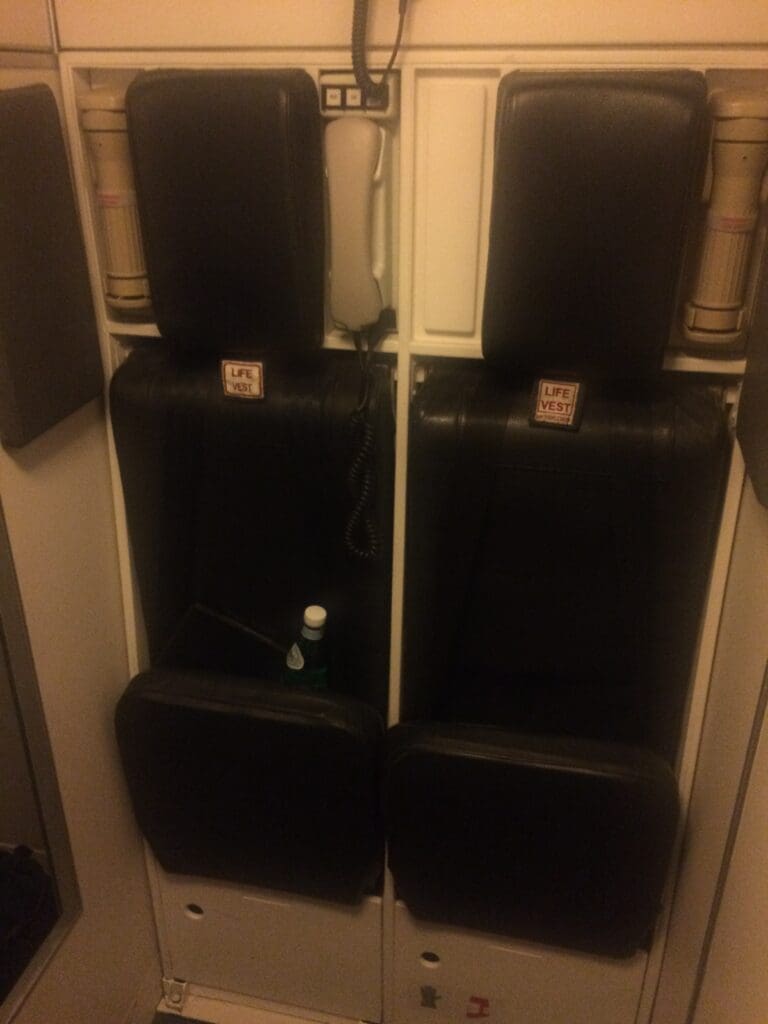
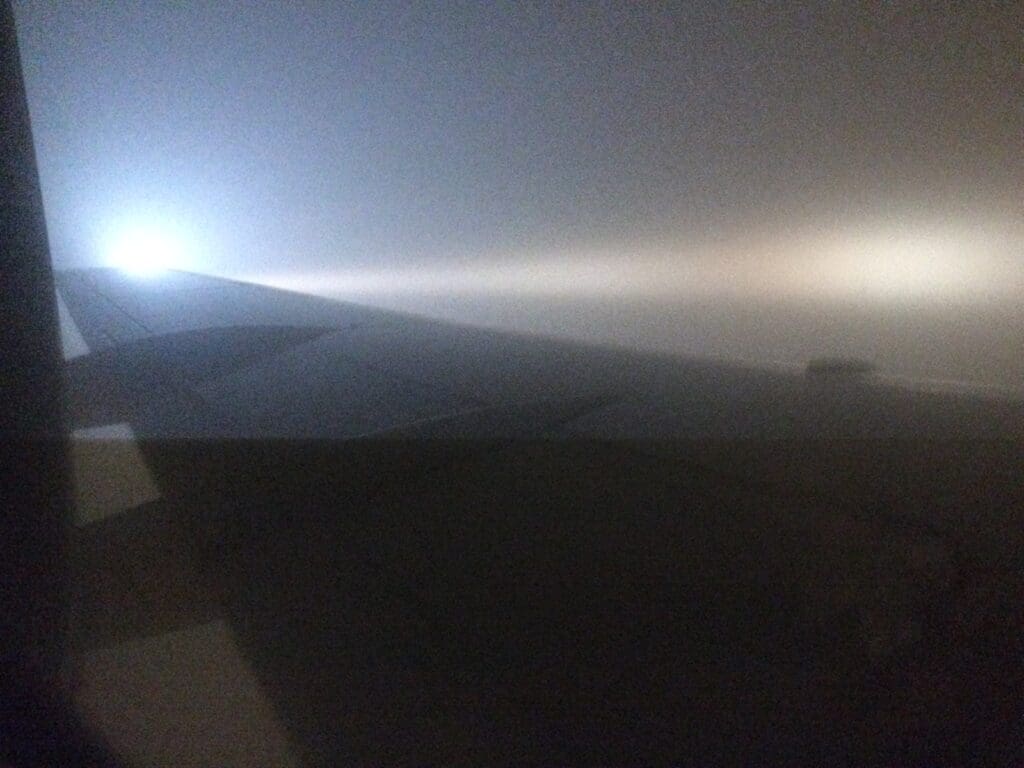
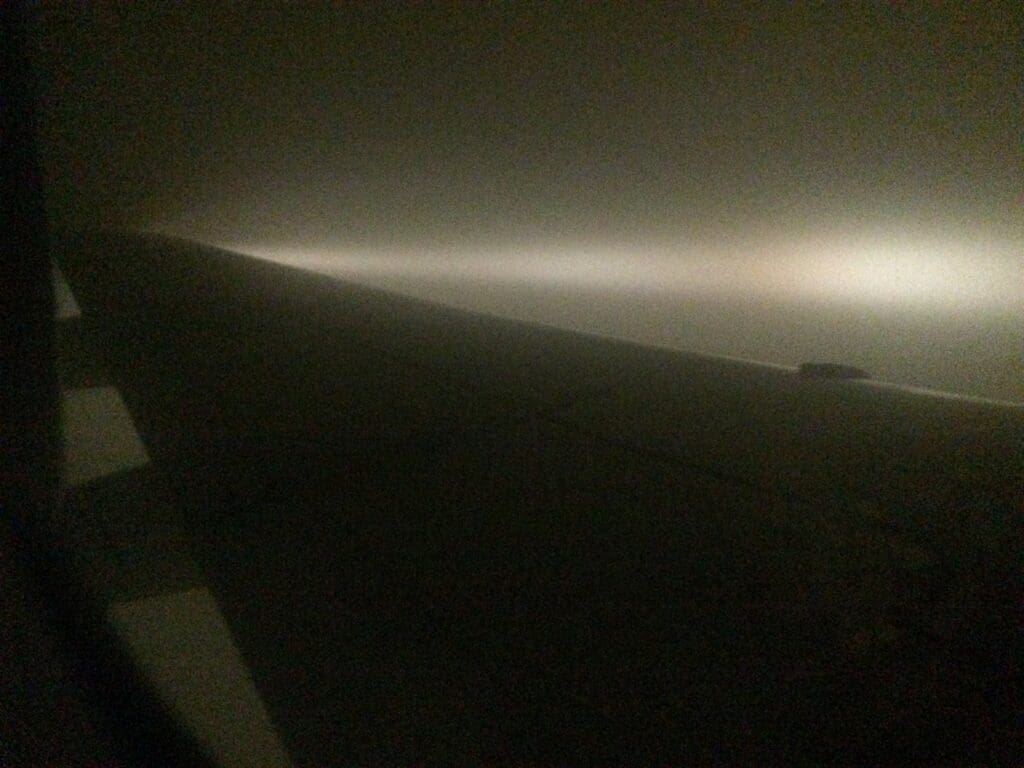
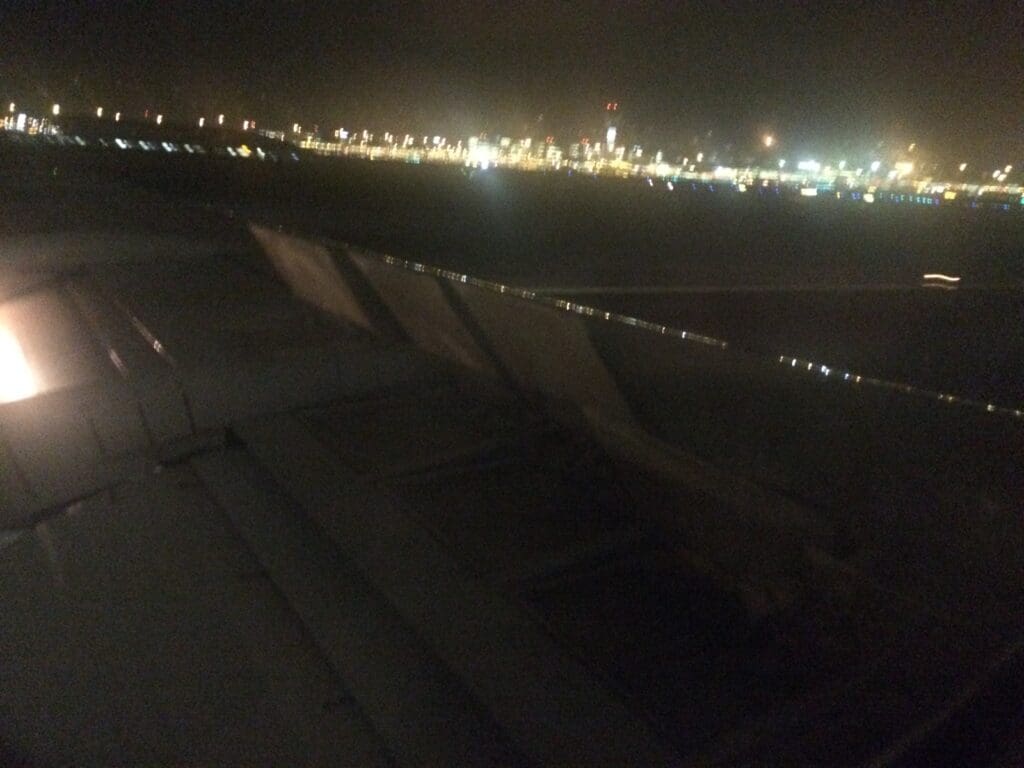
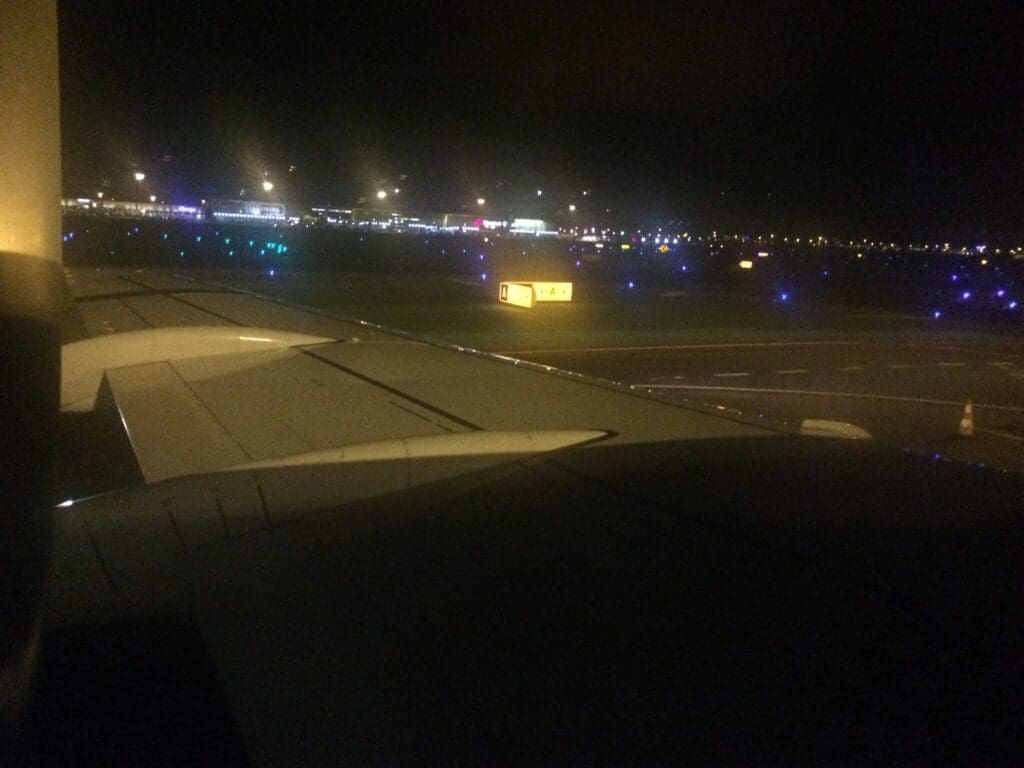
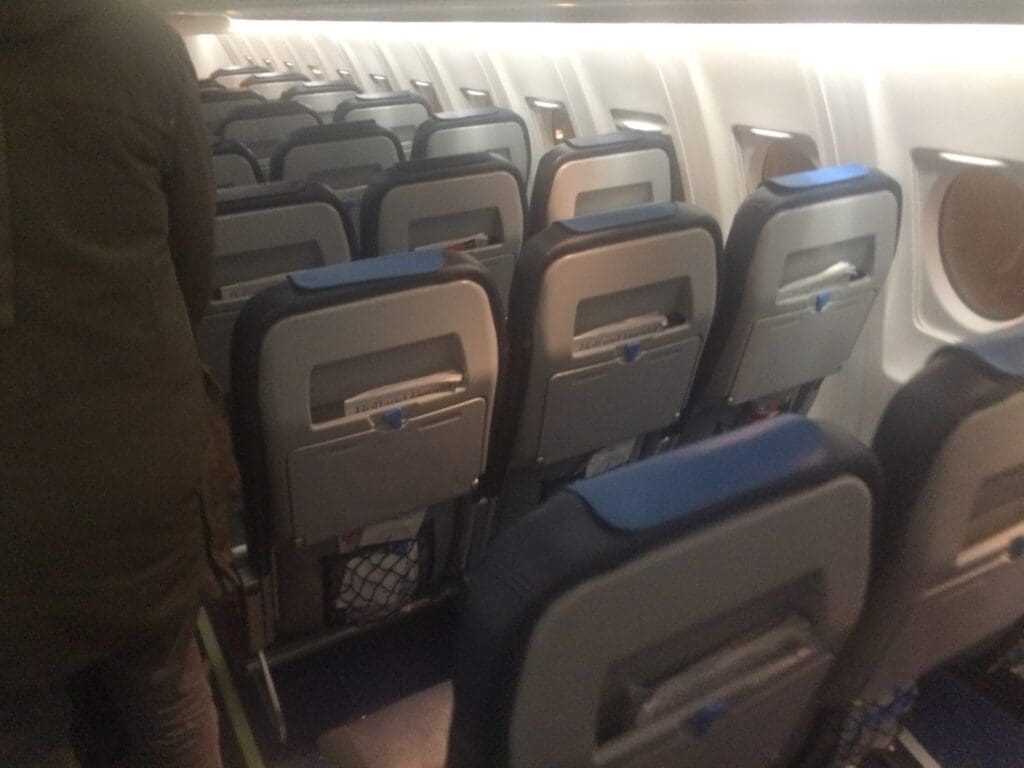
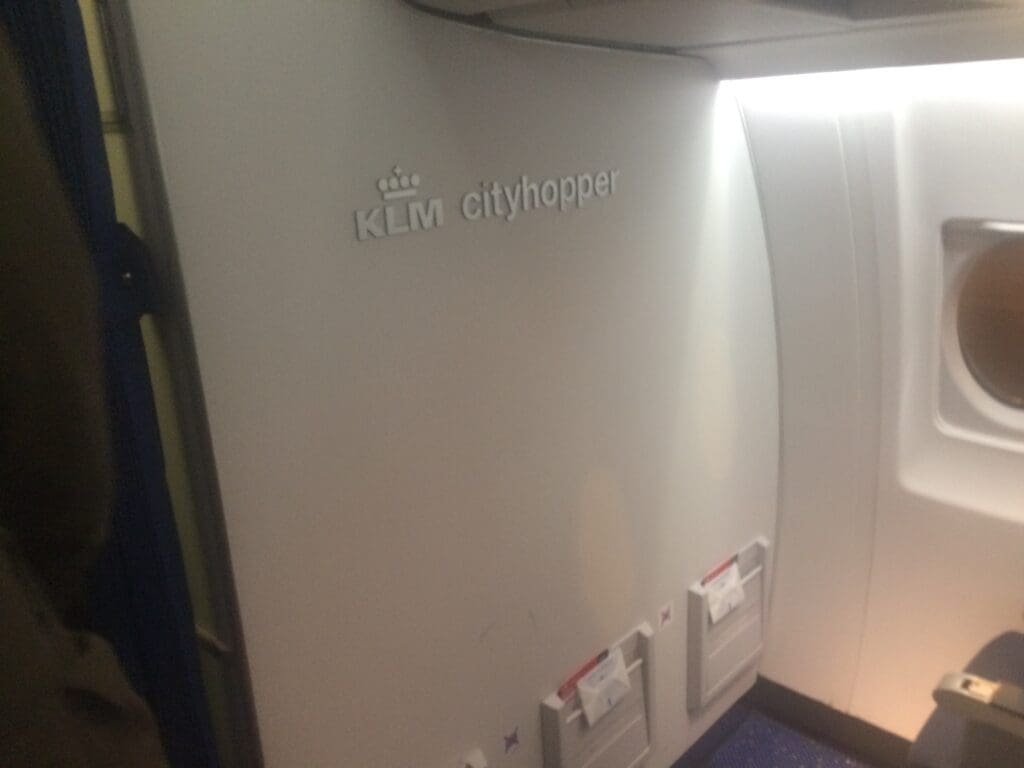
With my flight to Incheon set to depart from gate F8, a ten minute walk away from where I had been dropped off by the bus, I wandered over to this pier and took a seat whilst I waited for boarding to commence. Outside this, a Skyteam liveried Korean Air Airbus A330-200 could be seen being readied for its flight to Incheon. With this flight scheduled to depart at 2120, five minutes prior to the KLM service, this had been an option although being an enthusiast I could not resist flying on the rare Boeing 747 Combi! Other than this, several other widebody aircraft could be seen around this pier including a KLM Boeing 777-300ER bound for Kuala Lumpur and a Boeing 787-9 heading off to Cairo, as well as a Mexico City bound Aeromexico Boeing 787-8. Outside gate F8, Boeing 747-406M PH-BFR, named Rio de Janeiro could be seen being prepared for its flight over to Northeast Asia. Manufactured in Everett with the line number 1014, this particular aircraft took to the skies for the first time in January 1994 making it almost 23 years old at the time of my flight. In the week prior to my flight, this jumbo had operated services from its home in Amsterdam to Beijing, Chicago, Hong Kong, Houston and Seoul Incheon. Today, this is configured to carry a grand total of 268 passengers (35 in First, 36 in Premium Economy and 197 in Economy), with KLM’s Combi aircraft featuring 140 fewer seats (all in Economy) than their non-Combi Boeing 747s.
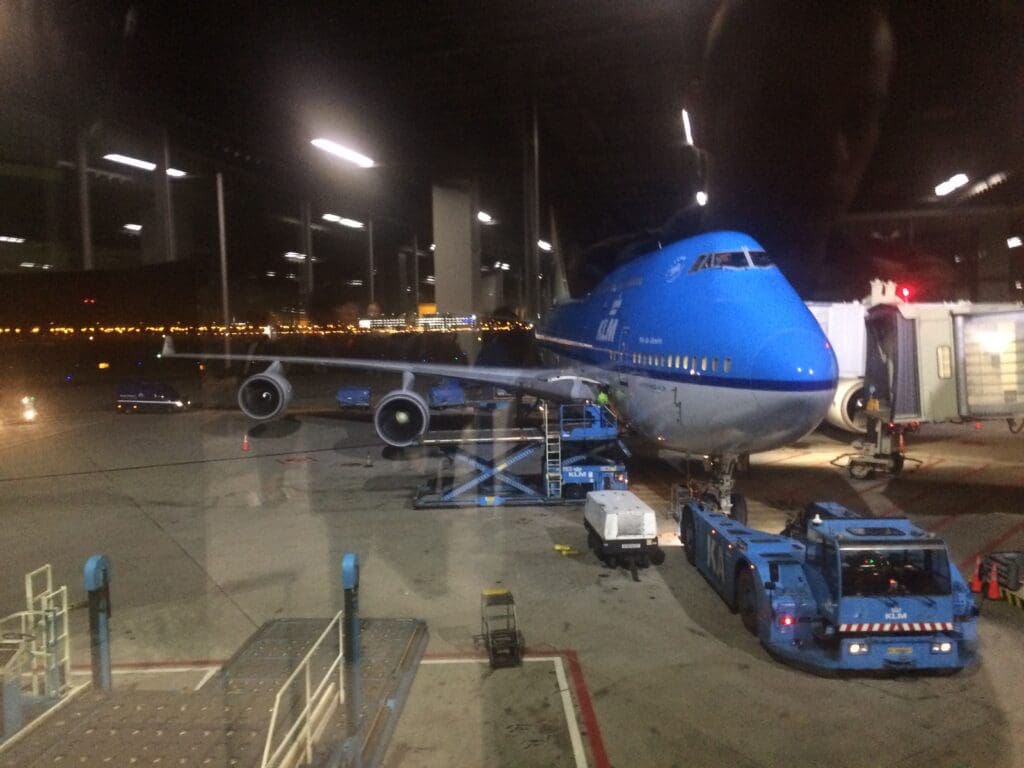
At 2040, boarding commenced and once all premium passengers had made their way onboard, I journeyed down the jetbridge towards the waiting aircraft. Upon making it to the jumbo jet, I stepped aboard and was immediately greeted by two Korean flight attendants – as with a number of other airlines, KLM operates a cabin crew base in Seoul to ensure that their flights to and from Korea are supported by Korean language speaking crew members. Turning right, I passed through the Premium Economy cabin before arriving in Economy and soon reached my row at the very rear of this cabin. That night, I was to travel back to Korea in the middle of a party of late middle aged and elderly travellers returning from their holiday to Spain who seemed to be rather disgruntled with the lack of storage space in the cabin. After squeezing past my two seatmates, I settled into the seat that I would call home for the next ten hours or so.

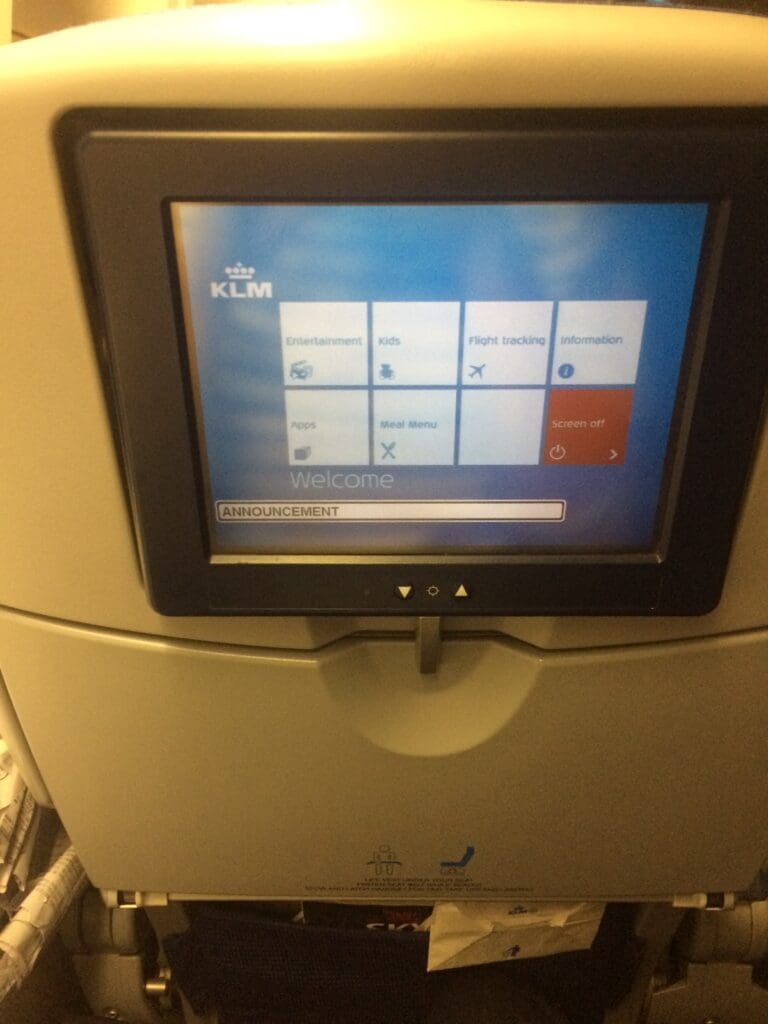
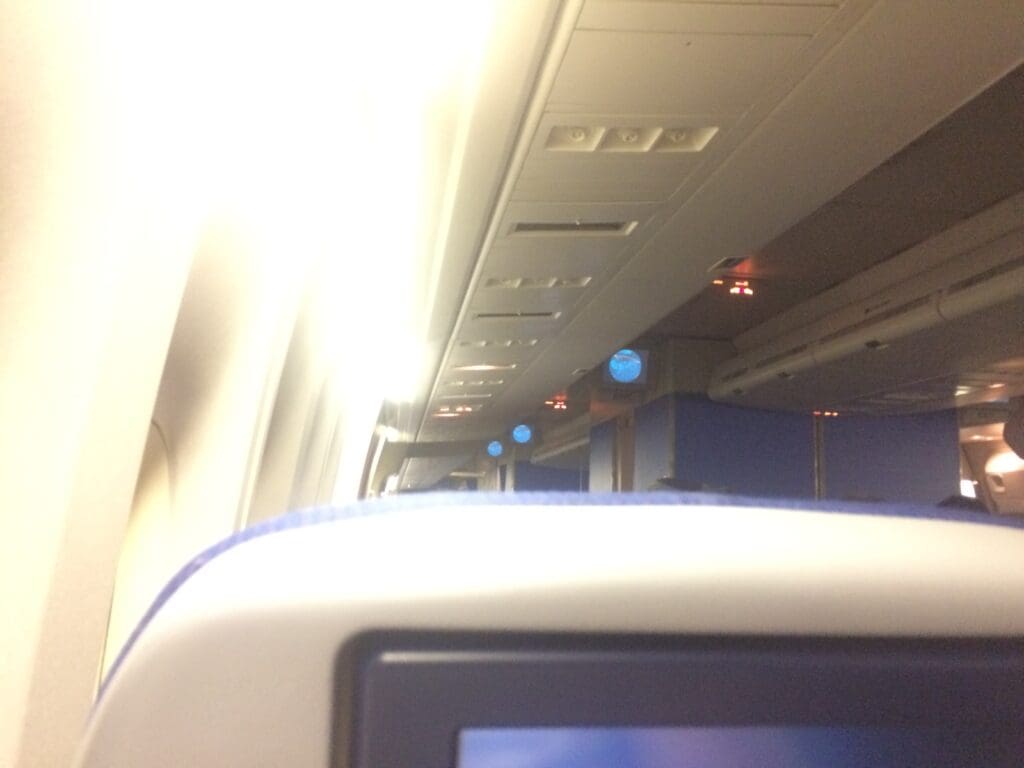
Having done my research, I was aware that KLM’s Economy seats on their Boeing 747s are old fashioned and lack the modcons of newer jets with no plug sockets, USB ports or even a touchscreen personal television. Thus, I was neither surprised nor disappointed to find myself sitting onboard a flying time capsule although other passengers may have been a little disappointed. On the positive side, I found the seat to be rather comfortable whilst blankets and pillows had been placed on each seat although no amenity kits were offered. As with the Fokker 70 that had shuttled me over from Humberside, the cabin seemed to be boiling hot and remained so for much of the flight. Furthermore, prior to pushback water seemed to drip down from the cabin ceiling and tissues could be seen jammed into several cracks in the panels up ahead in an effort to prevent water dripping onto passengers.
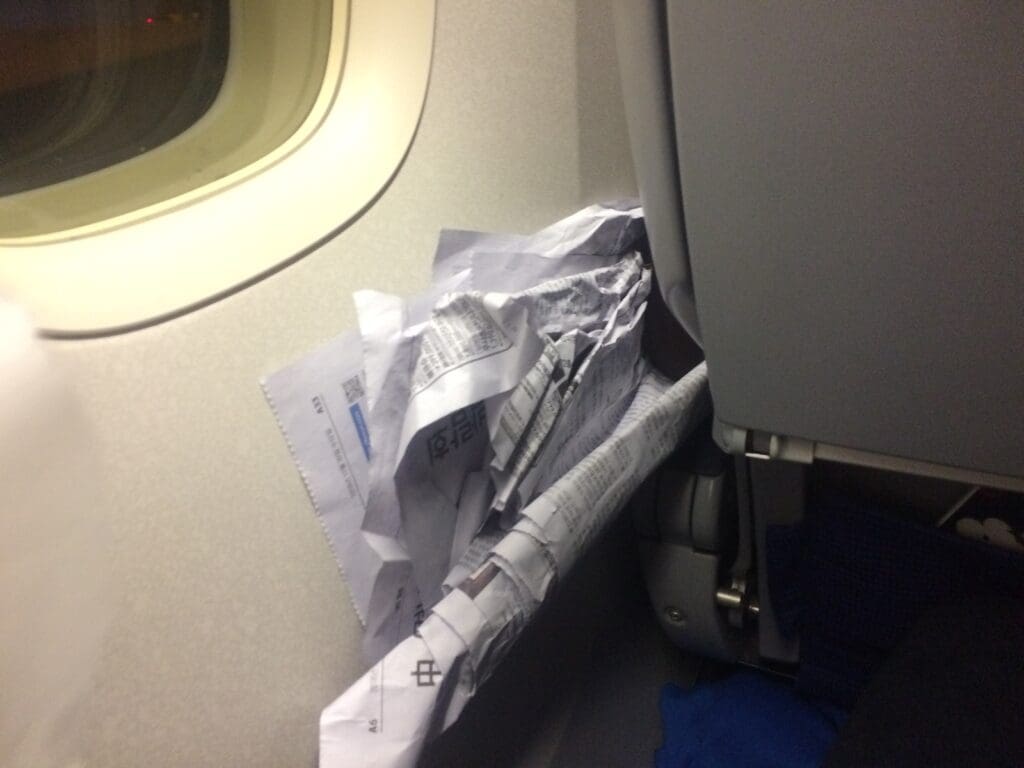

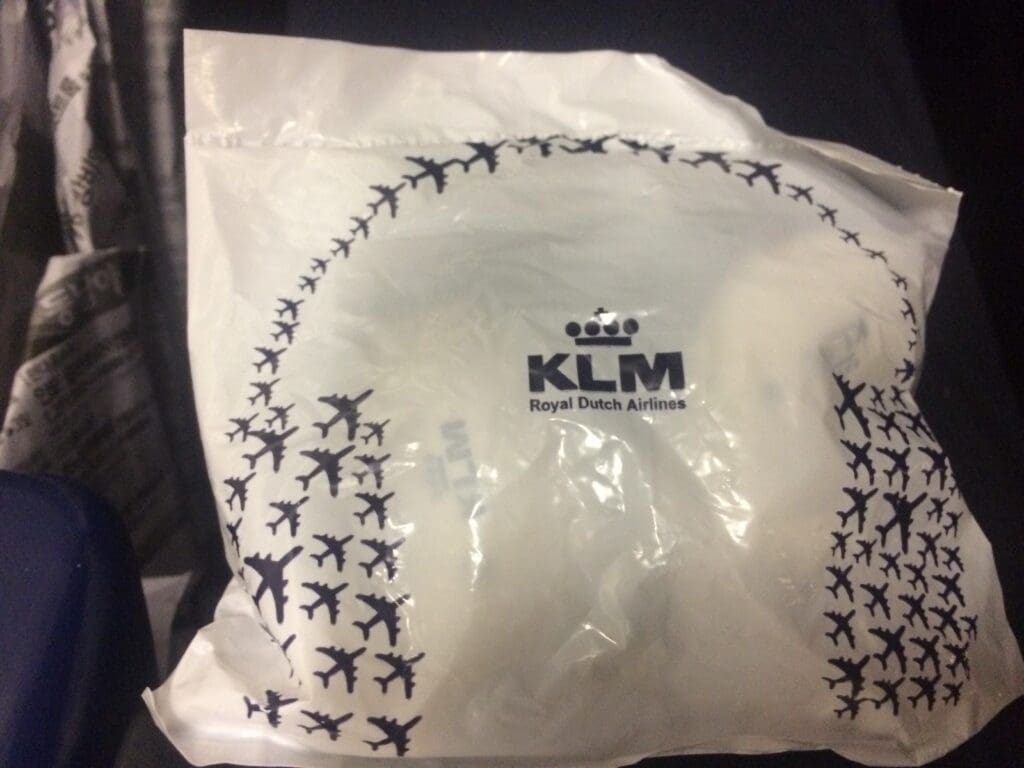

By 2120, all passengers appeared to have made their way onto the aircraft and it seemed that all was set for our journey to Korea. Indeed, this may well have been the case had we been on a more conventional airliner however from my seat at the rear of the passenger cabin I could see that a long line of various bits of cargo could be seen waiting to be loaded into the cargo section of the aircraft – with one of the more unusual items of cargo consisting of a car! With our scheduled departure time of 2125 coming and going with no sign of movement, at 2135 the captain performed a welcome announcement in Dutch and English during which they informed passengers that we were still waiting for an important piece of cargo to arrive at the aircraft. After another fifteen minutes of waiting, the captain made their second announcement whereby they informed passengers that this was in the process of being loaded and that we would push back from the gate in five minutes’ time. Finally at 2200, the aircraft could be felt jolting back away from the terminal and one-by-one the Boeing’s General Electric CF6-80C2B1F engines powered up into life.
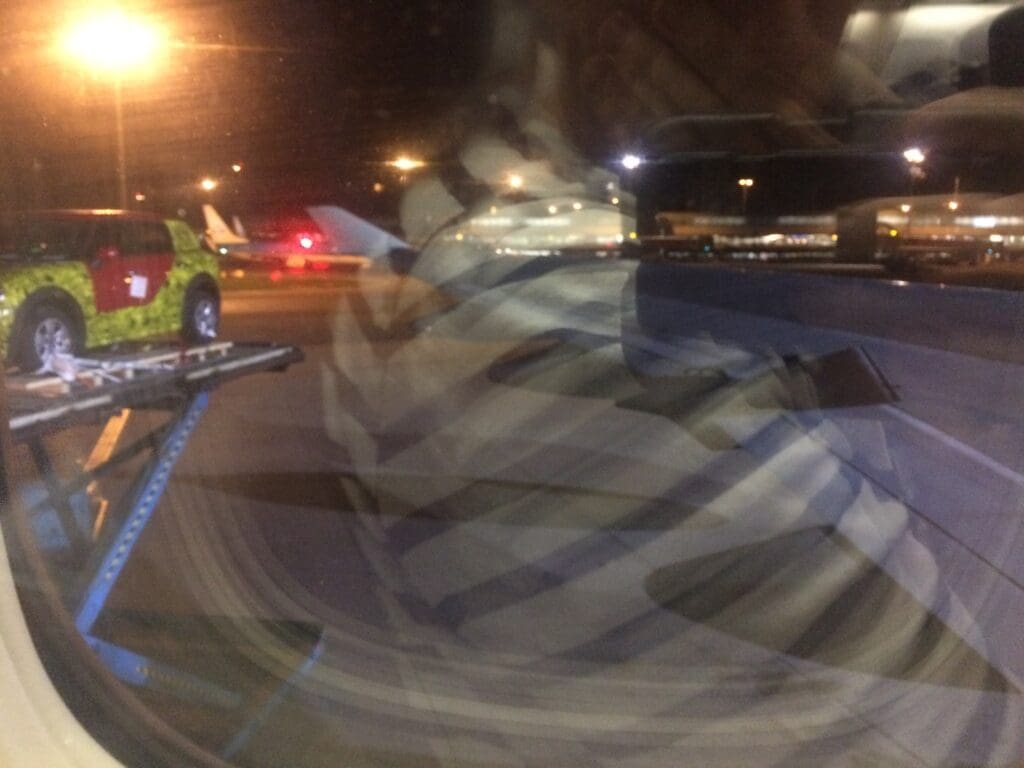
During our pushback, the cabin crew performed welcome speeches in Dutch, English and Korean before the safety video took over passengers’ personal television screens with this played in English and accompanied by Korean subtitles. Unfortunately, the speakers in my part of the cabin did not seem to be working too well and yet to receive any headphones the safety instructors were barely audible. Turning back to the progress of our flight, once the tug was disconnected, the aircraft commenced its long taxi over to the Polderbaan.
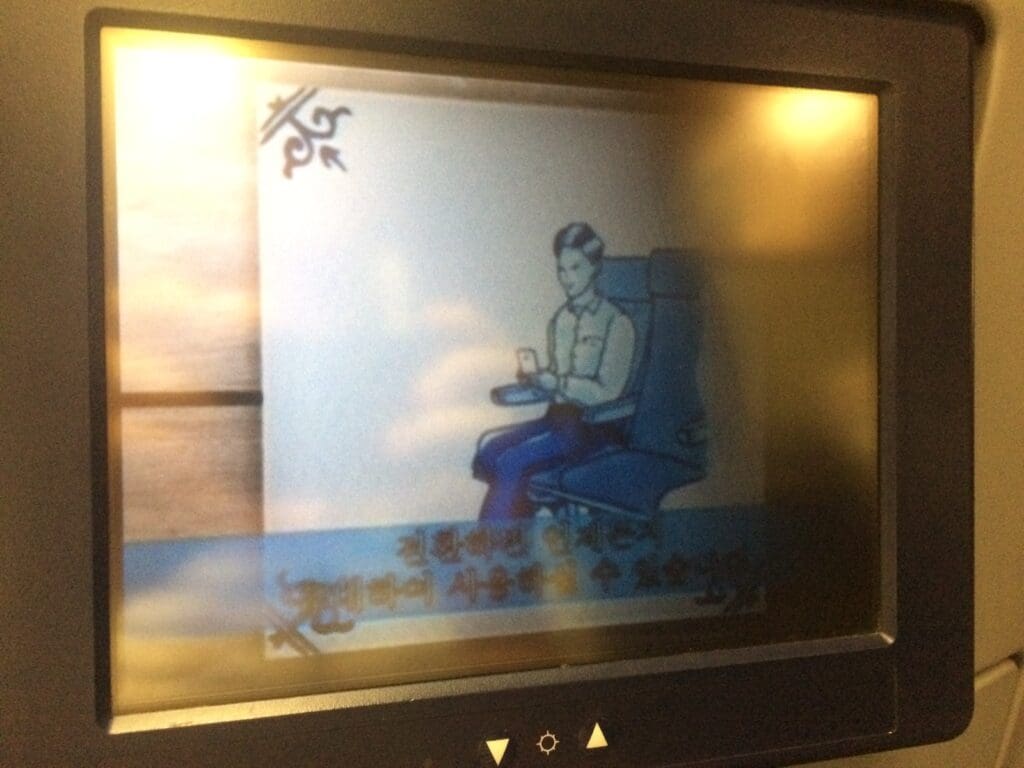
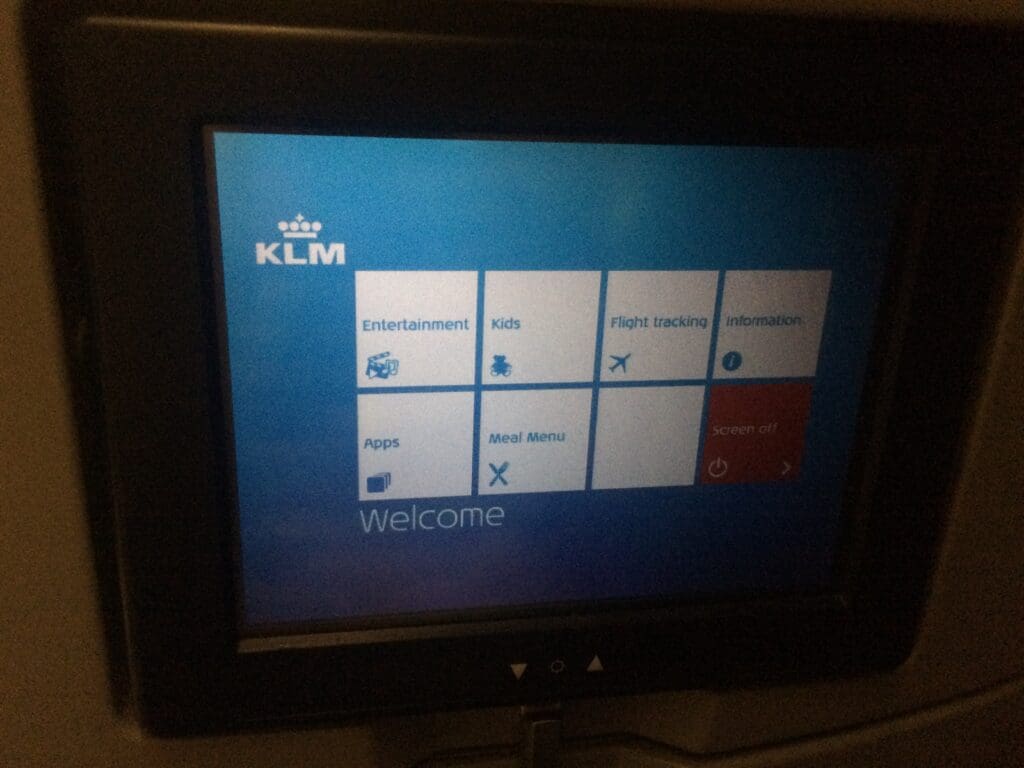
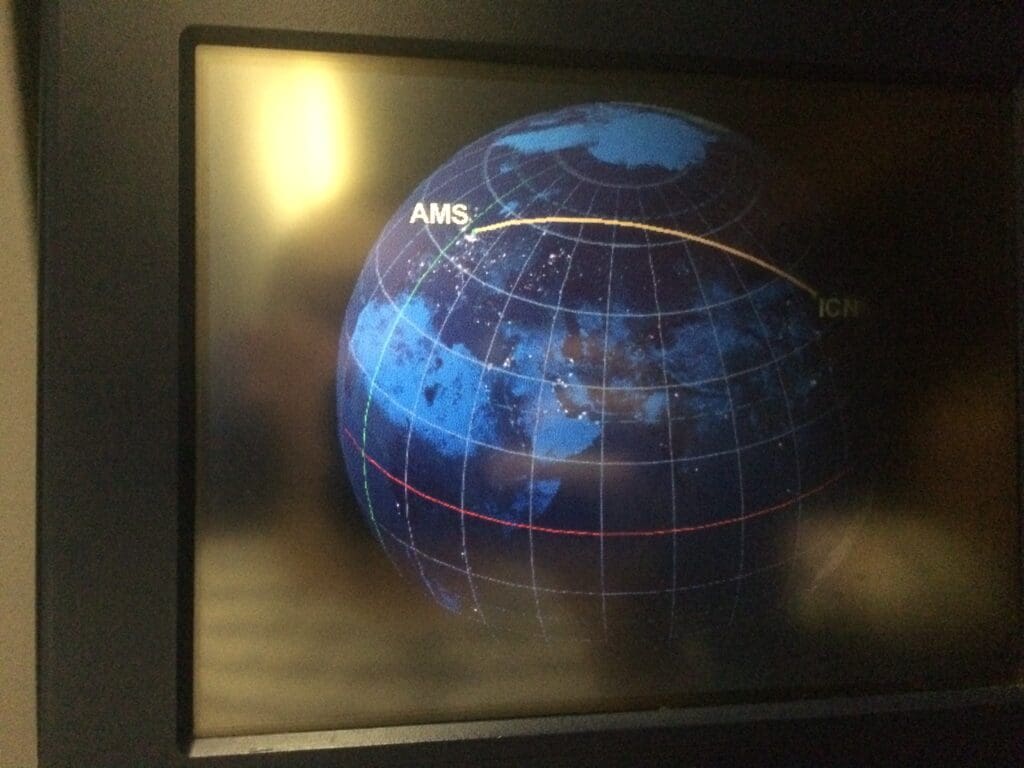
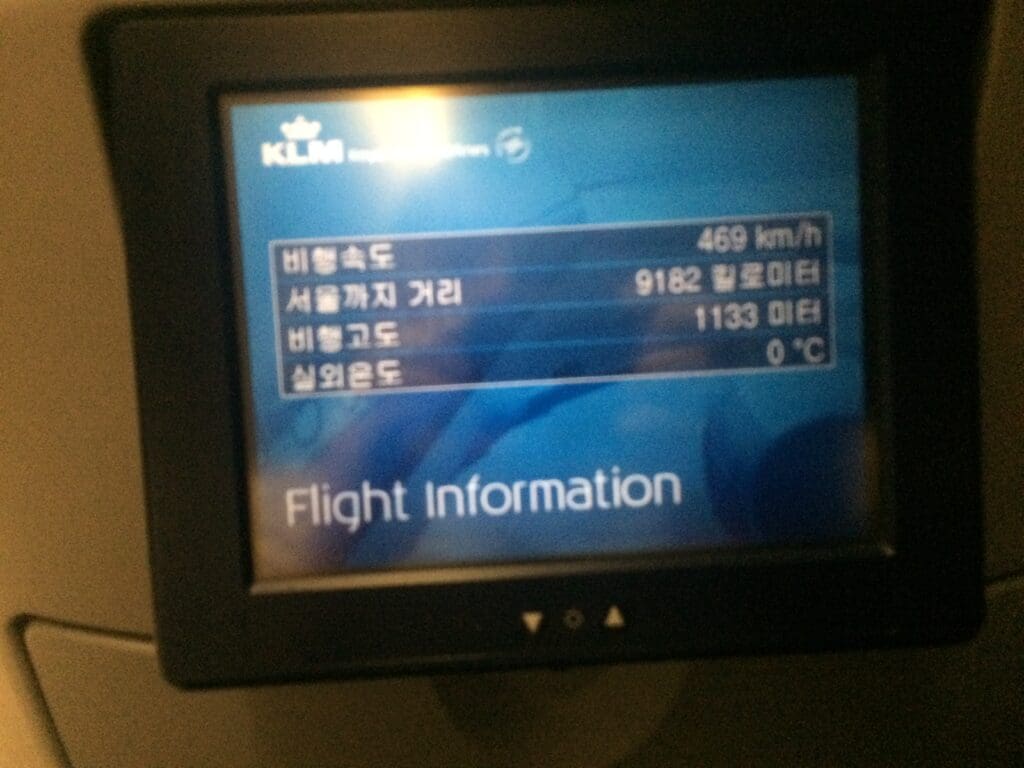
Once at the runway, with no other aircraft in front of us, at 2217 the Boeing performed a long and gentle take-off roll with plenty of shuddering as we rotated upwards into the Dutch night sky. Following our departure, the Boeing continued to fly northwards which allowed for views of Haarlem, whilst those on the opposite side of the cabin would have been treated to picturesque vistas of the lights of Amsterdam. After passing the Dutch capital, the aircraft then turned northeastwards and headed towards the city of Groningen, with our route that night taking us over Germany, Denmark and Southern Sweden before heading out over the Baltic, making landfall over Estonia, we crossed the border into Russia just south of St Petersburg and reached the most northerly point of the flight near Cherepovets. Our route over Russia took us over Perm, Tyumen, north of Omsk and south of Novosibirsk. We crossed the Mongolian border with around 4 hours left of the flight and flew across the country before crossing into China’s inner Mongolia before heading almost directly southwards to Beijing and Tianjin before heading eastwards over the Yellow Sea and then southeastwards in order to skirt around North Korean airspace.
As we climbed the cabin crew made another long announcement however again, this was barely audible. Headphones were then handed out as we climbed upwards and so at this point I decided to explore the delights of KLM’s inflight entertainment system. In spite of the old fashioned nature of this system, the selection of content offered on this seemed to be very reasonable. I should however mention that the system crashed as I was exploring this, although fortunately it did reload itself – something that I experienced three more times during the course of the flight.
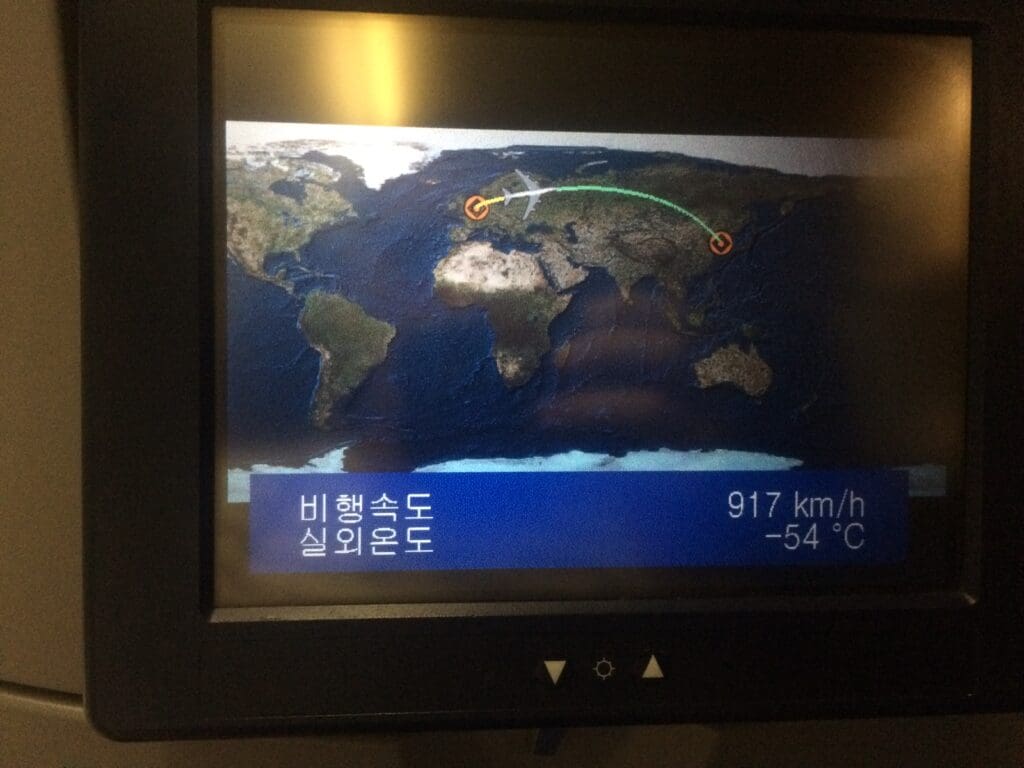

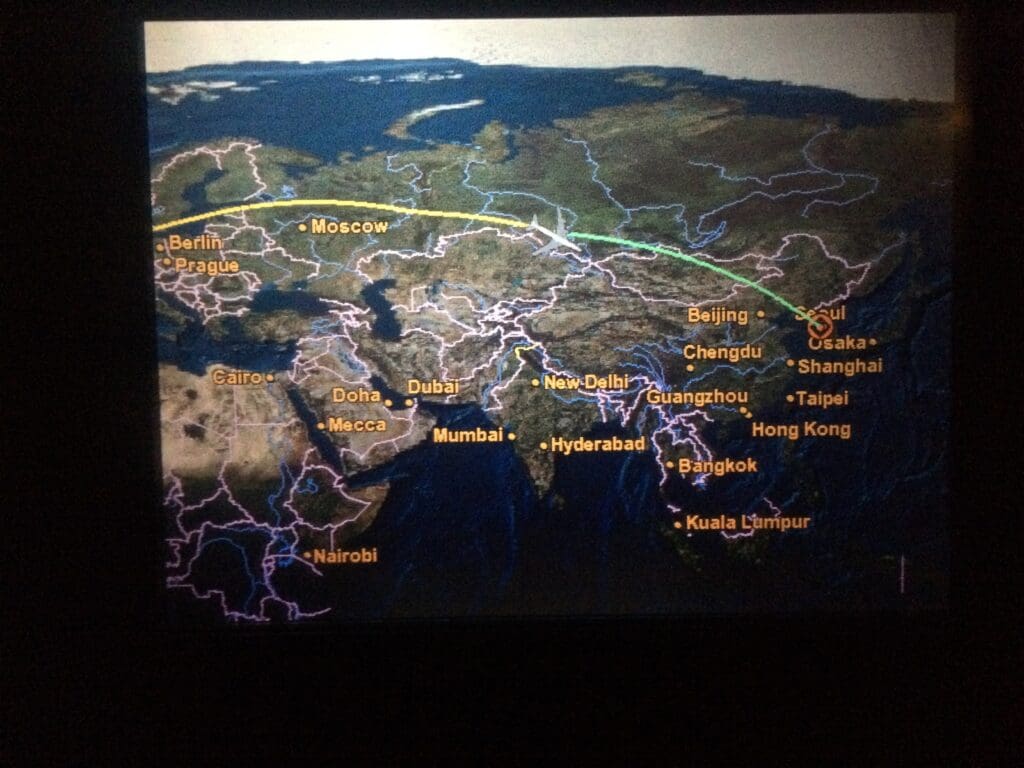
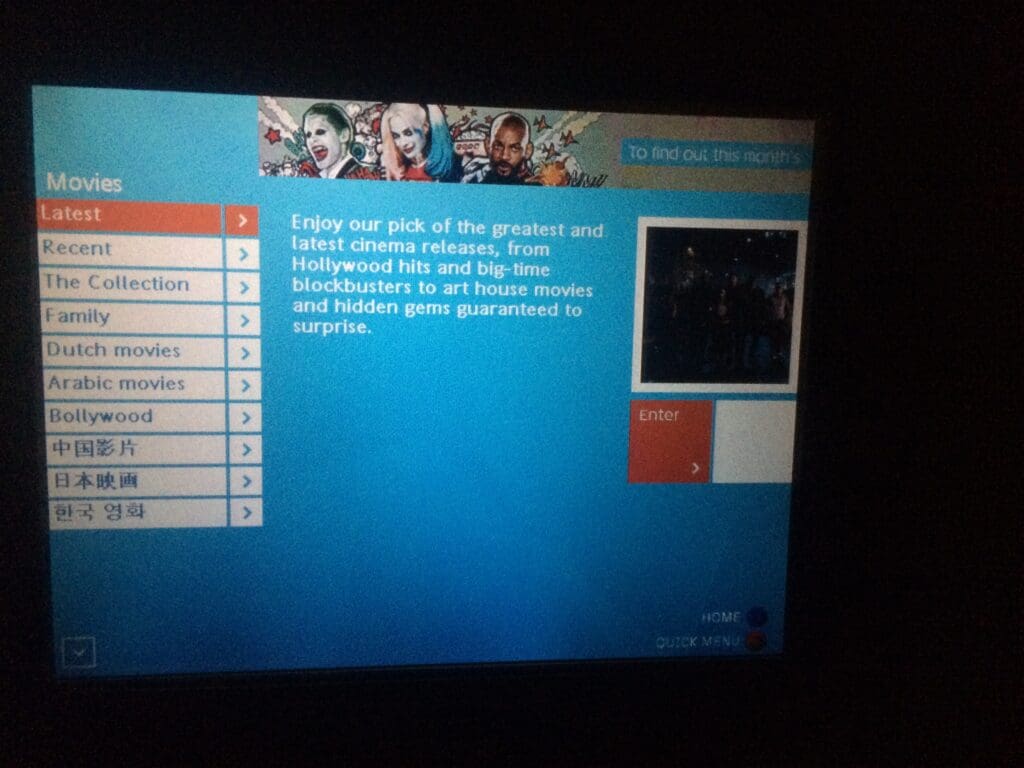
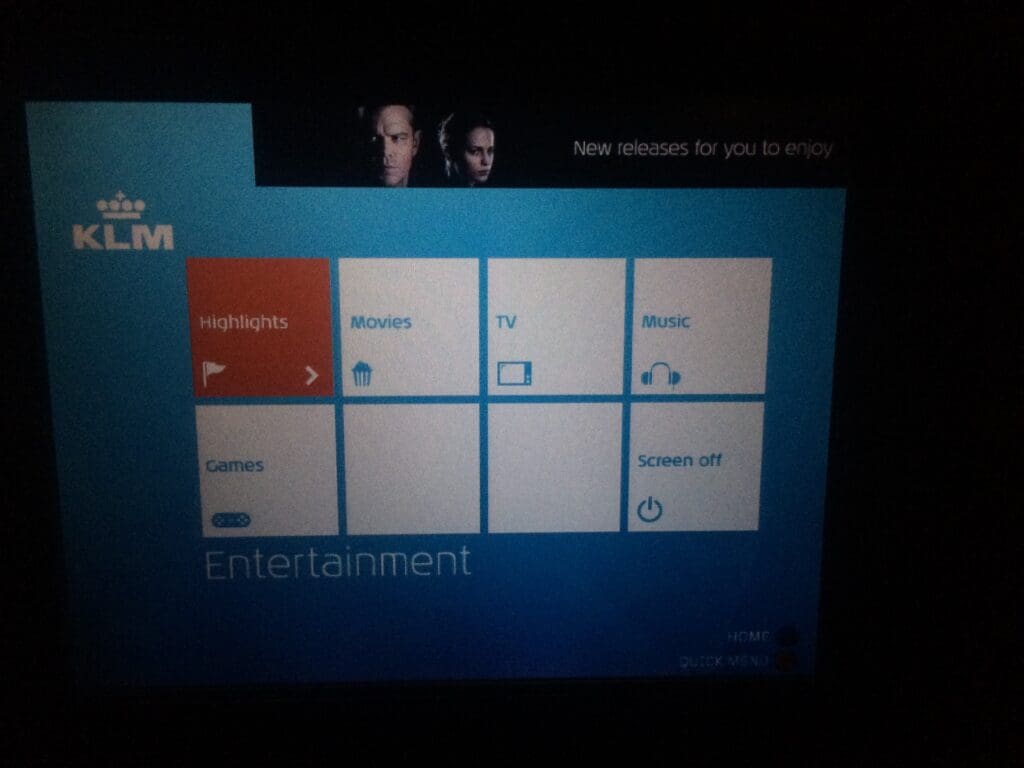
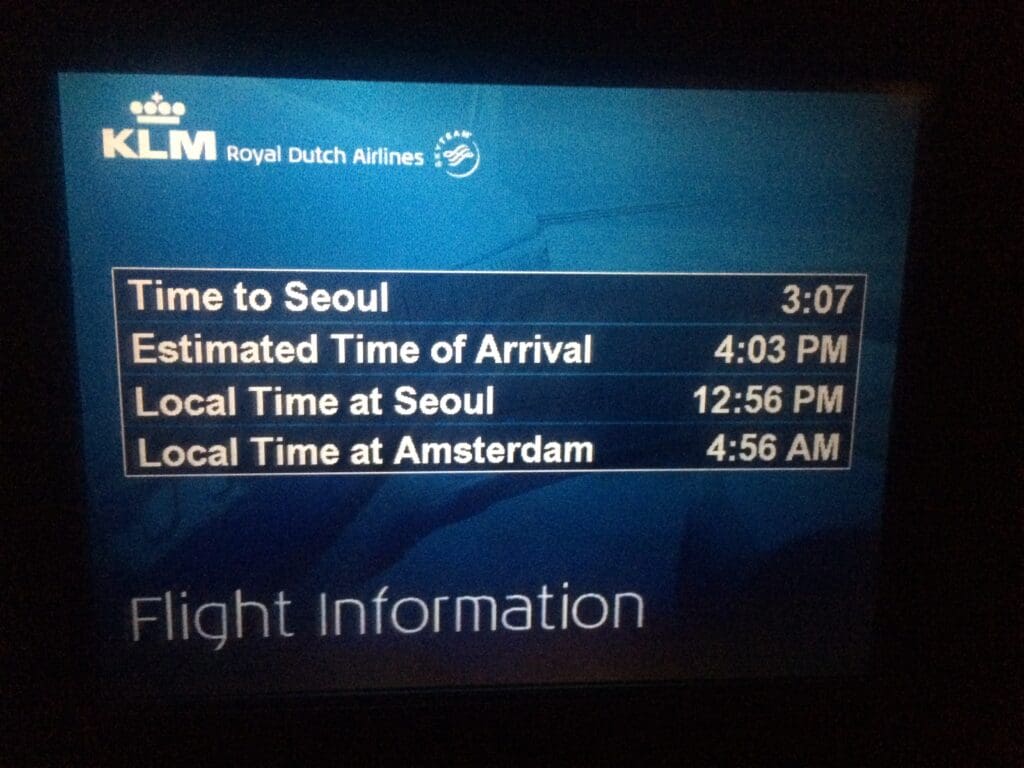
As we levelled off at 31,000 feet, the cabin crew came around with drinks and peanuts and at around 2330 Dutch time, the late evening meal was served. That night, the meal options took the form of either chicken or beef meatballs. Opting for the former, this took the form of Korean style chicken which came drizzled in a sauce and accompanied with japchae noodles and carrots, as well as a coleslaw salad, bread, crackers and a profiterole pudding. Admittedly, there was nothing too Korean about the chicken and it didn’t seem at all spicy, although it was indeed delicious. Furthermore, the portion sizes were good and the meal was presented in a rather nice way albeit with plastic cutlery.
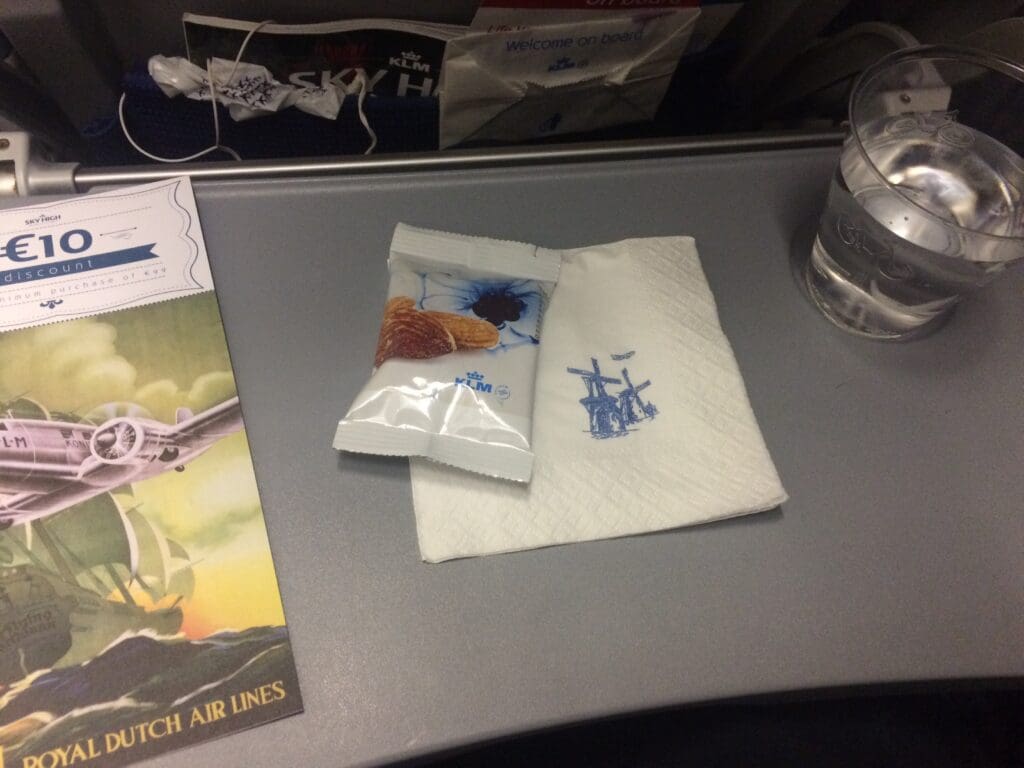
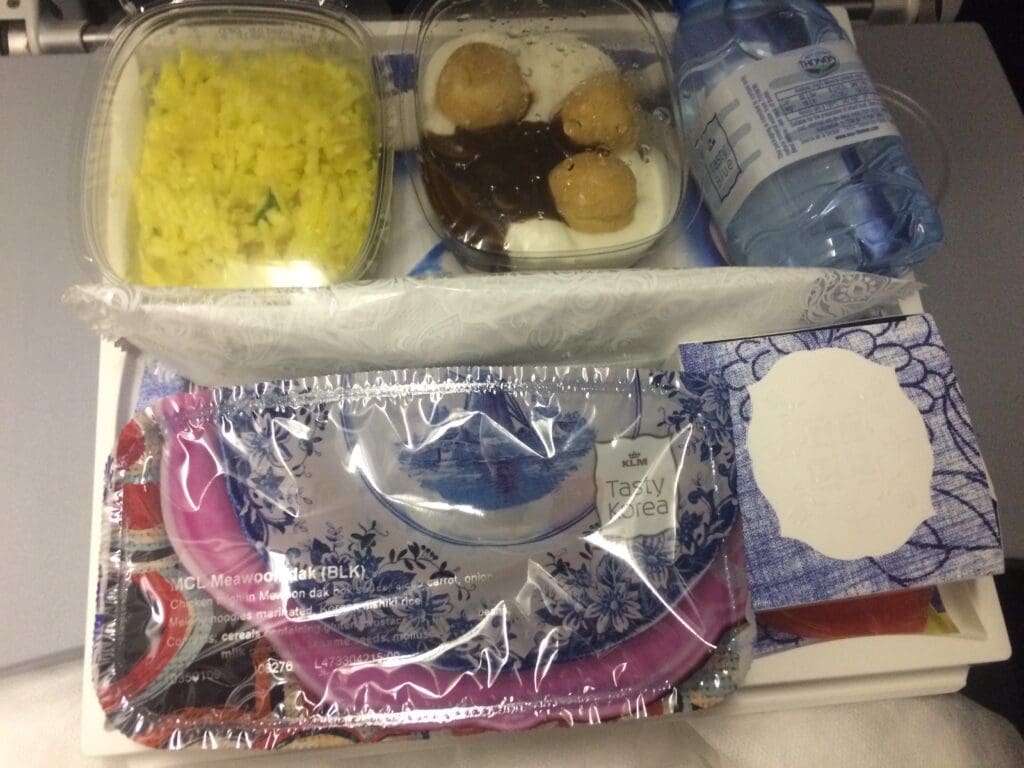

Both me and my two seatmates finished the meal rather quickly and instead of waiting for the trays to be collected, my seatmates summoned a crew member and ordered them to take them away. Noticing that I had also finished, one of the flight attendants also took away my try. . I have to say, whilst I would have never asked the crew to take my tray early, as I wanted to sleep I was rather happy that my seatmates did this. After collecting the other passenger’s trays and coming around with tea and coffee, the lights were dimmed and the cabin was plunged into darkness. After watching an episode of Top Gear, I too attempted to sleep. Whilst I was successful at first, I woke up after about an hour of sleep with this pattern continuing for some time. After my third cycle I gave up on sleep and during this stage of the flight the cabin crew seemed to disappear. Unlike on Korean Air, where the cabin crew seemed to be constantly patrolling the aisles, I only counted one occasion when a crew member came along offering drinks from a tray.
As we cruised eastwards over the Siberian wilderness, the sun began to rise outside, although not wanting to annoy my seatmates and get told off by the crew, I kept my window shade closed until the cabin lights were switched back on. By the time the cabin lights were switched on, the aircraft was high above the frozen hilly landscape of Northeastern China, with the snow below beginning to fade as we cruised towards the concrete jungles of Beijing and Tianjin.
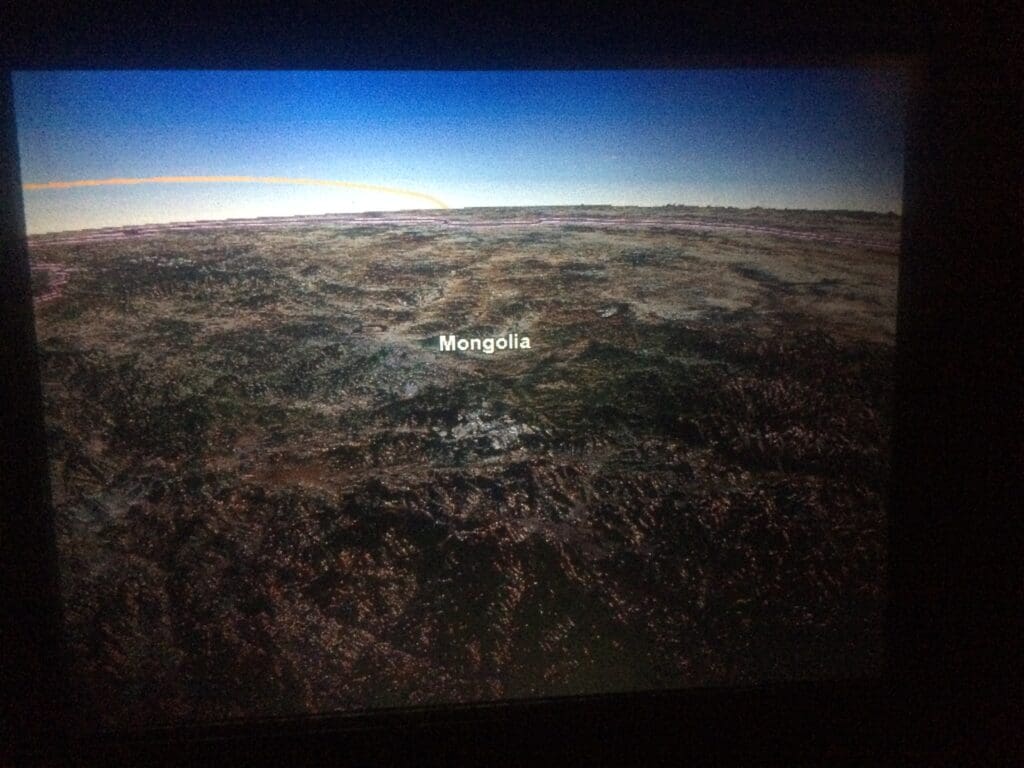
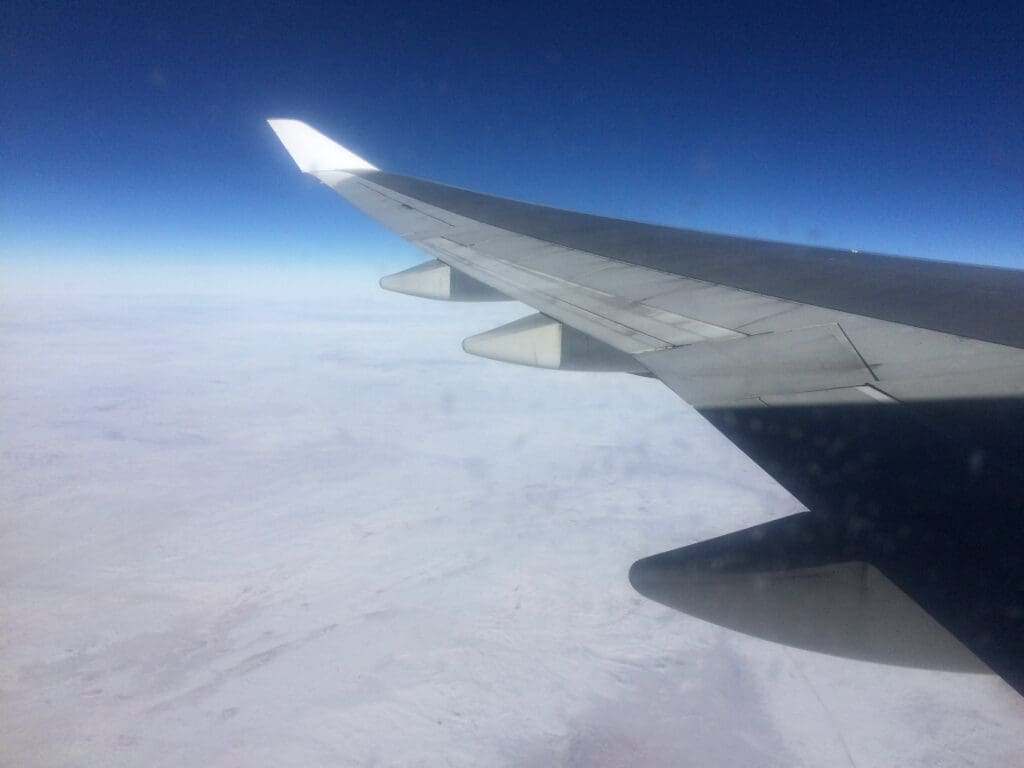
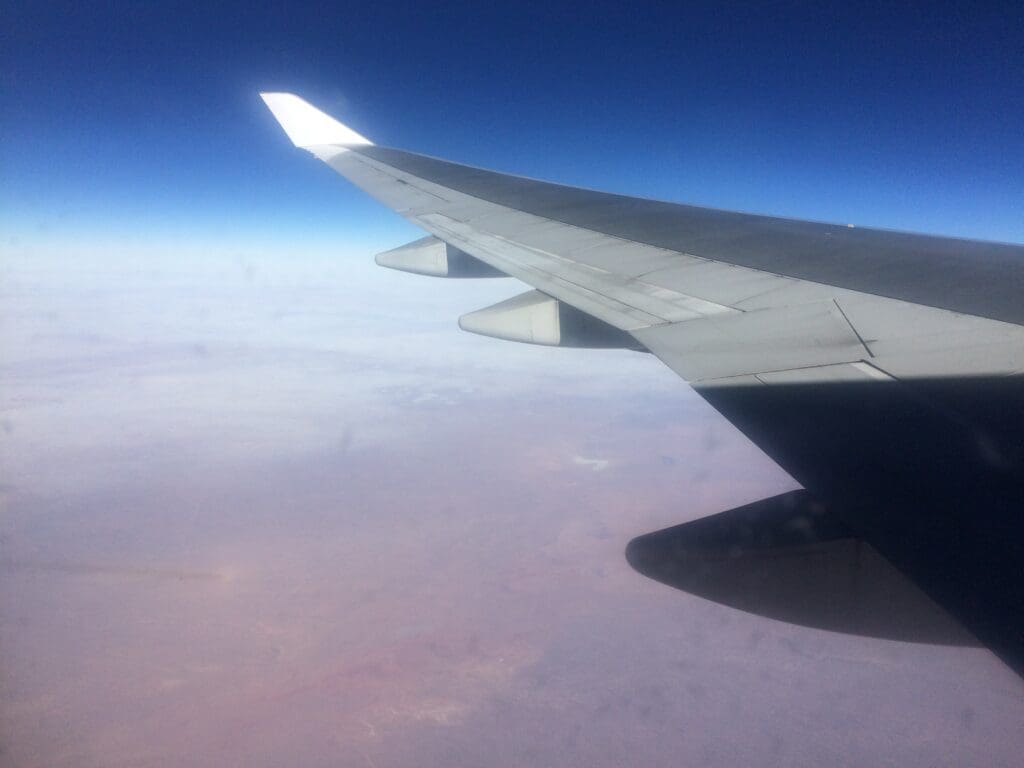
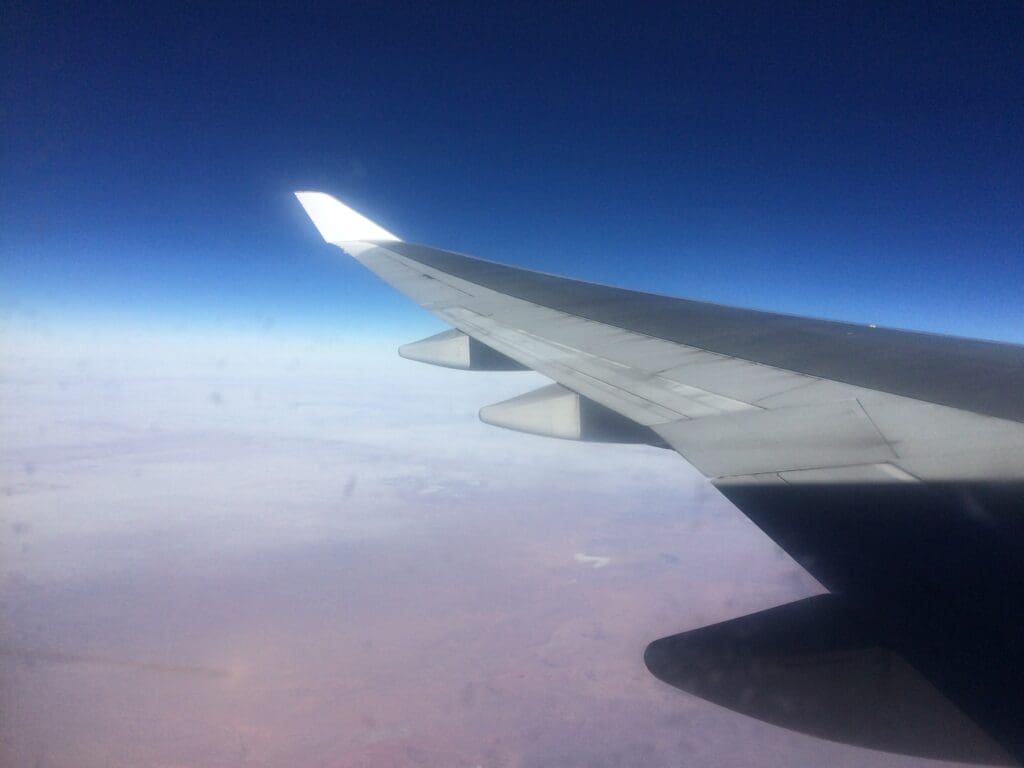
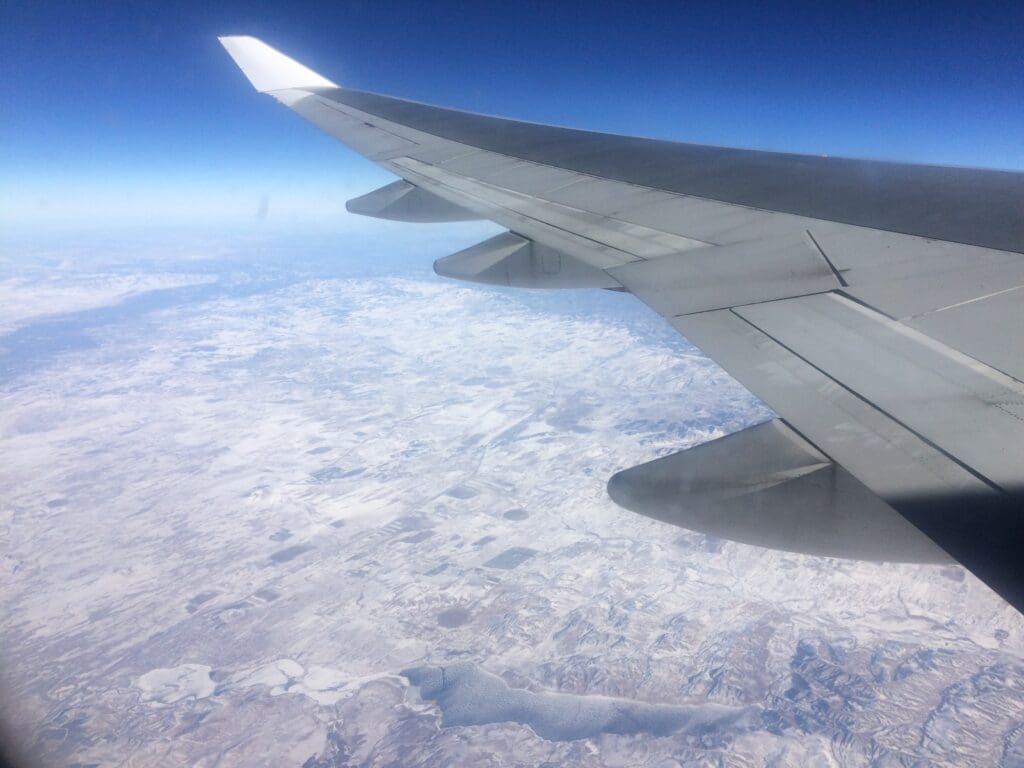
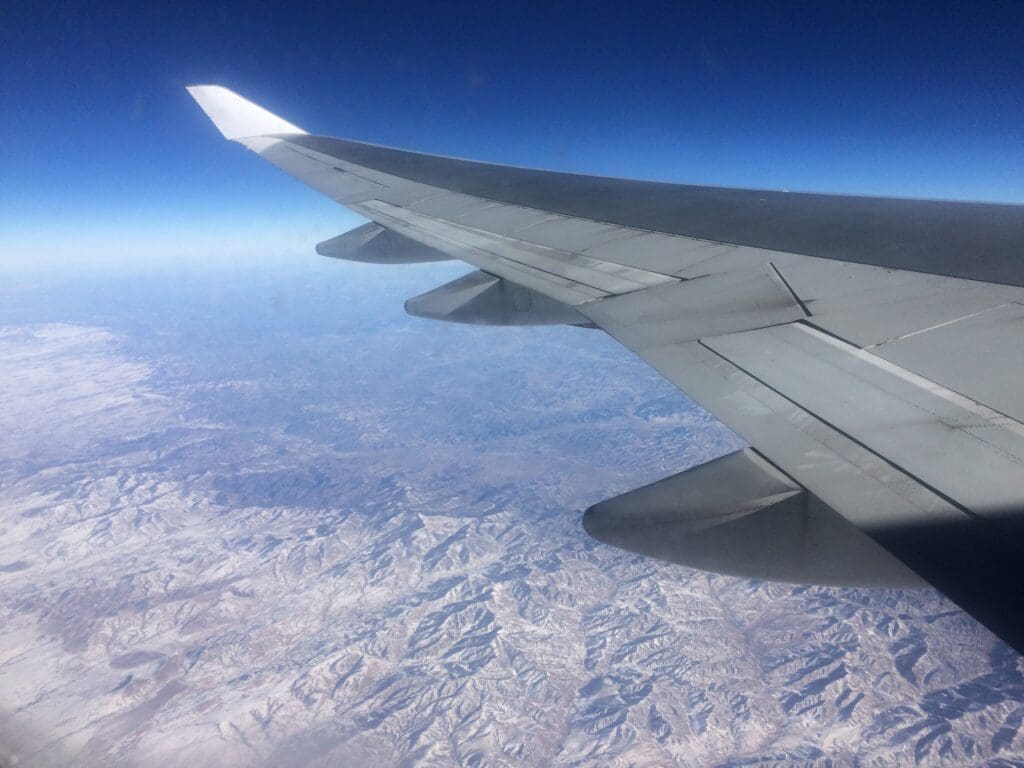
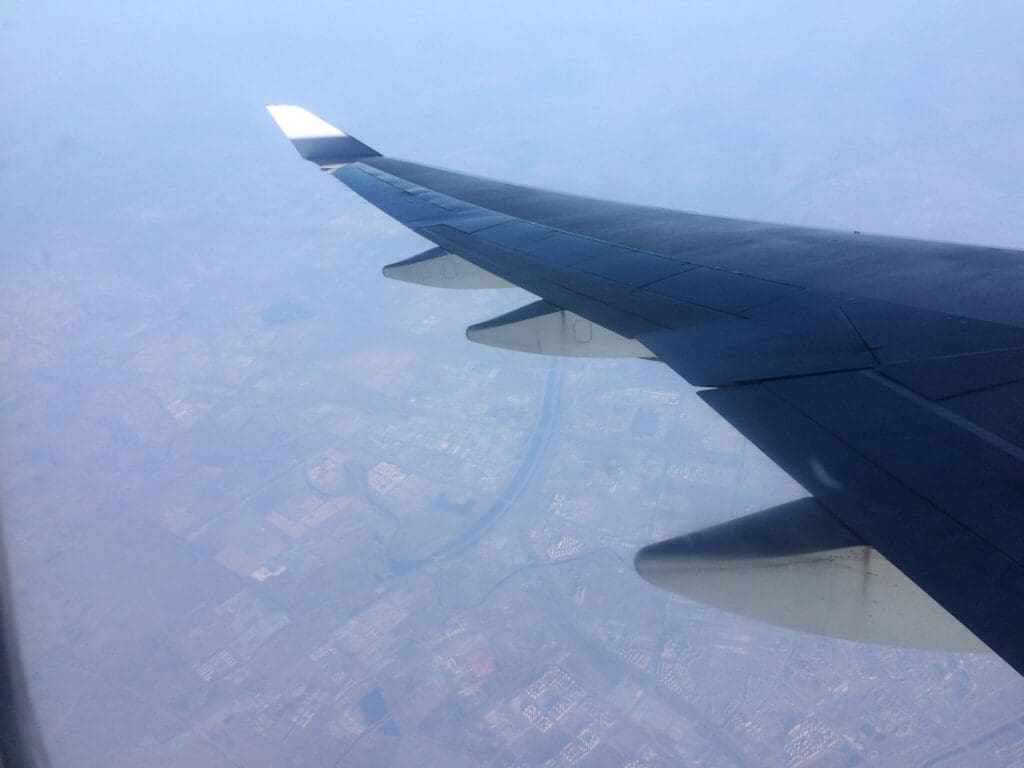
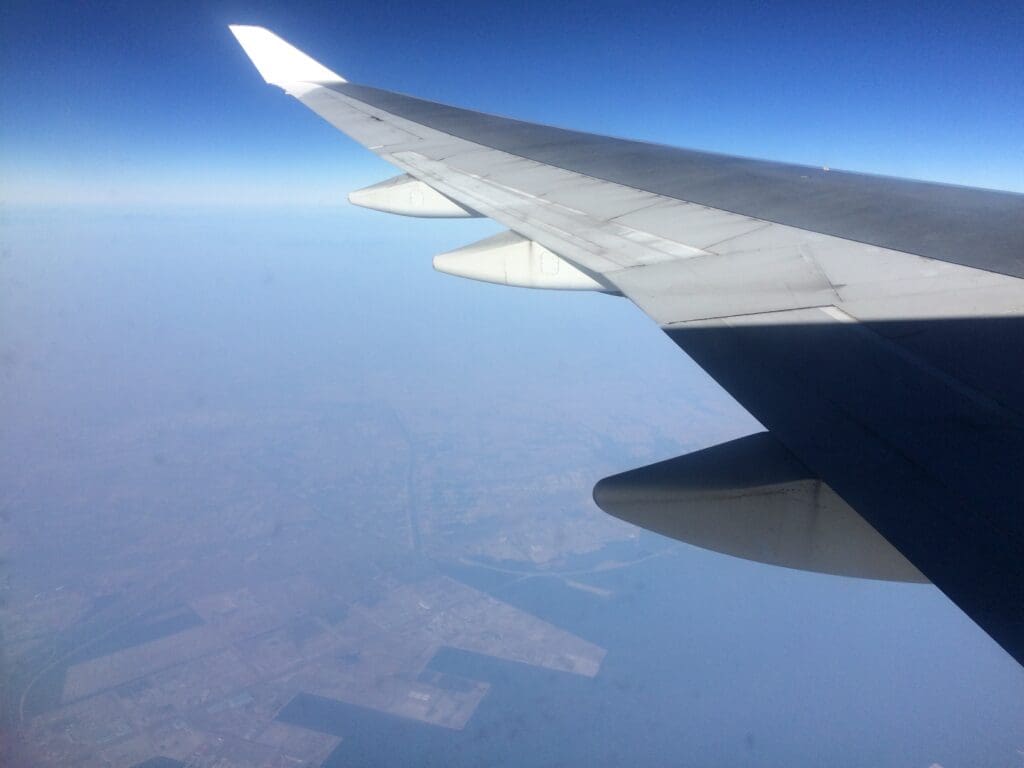
With around an hour and a half of flying time left breakfast was served, although I skipped this and just opted for an apple juice. A visit to the bathrooms revealed that these were in an okay state, not perfect but not bad although these did seem to be very dated in their design. After trays were cleared and immigration forms handed out, the Boeing began its descent which for the first stages appeared to be in tandem with a Korean Air Airbus A380 that had spent the night travelling from Paris CDG. As we neared the Korean Peninsula, we conducted a few small turns (what seemed like traffic spacing manoeuvres) and the A380 left us behind. The relatively cloudless skies meant I was offered a view of the southern shores of southwestern North Korea as we sank towards Incheon.
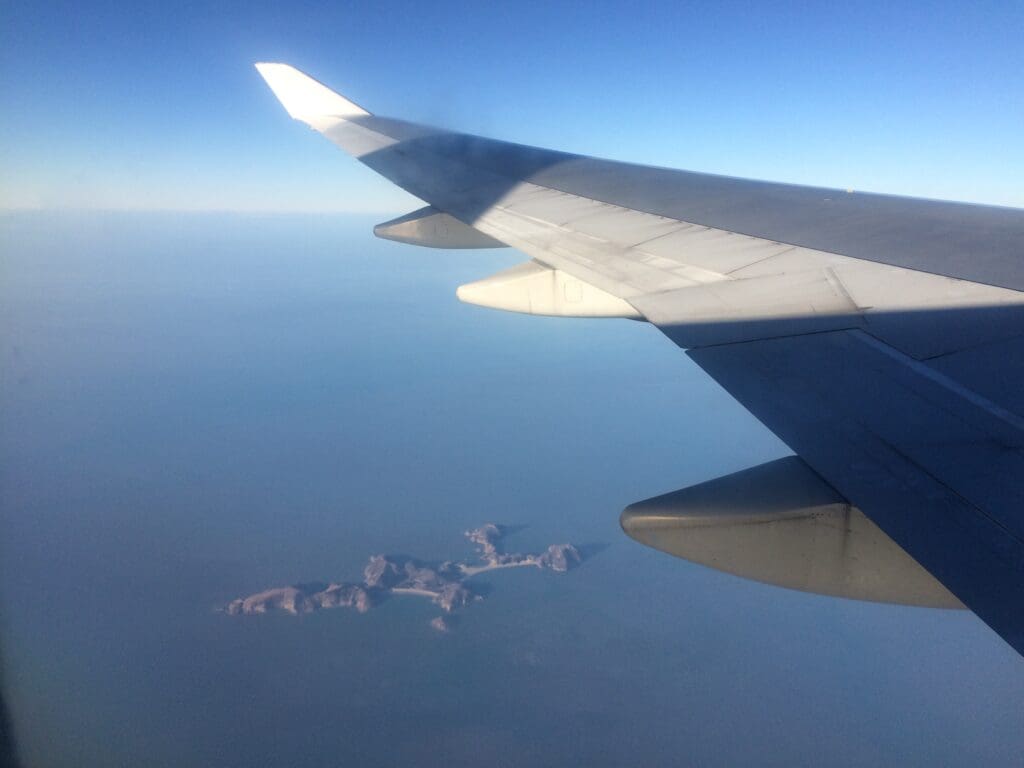
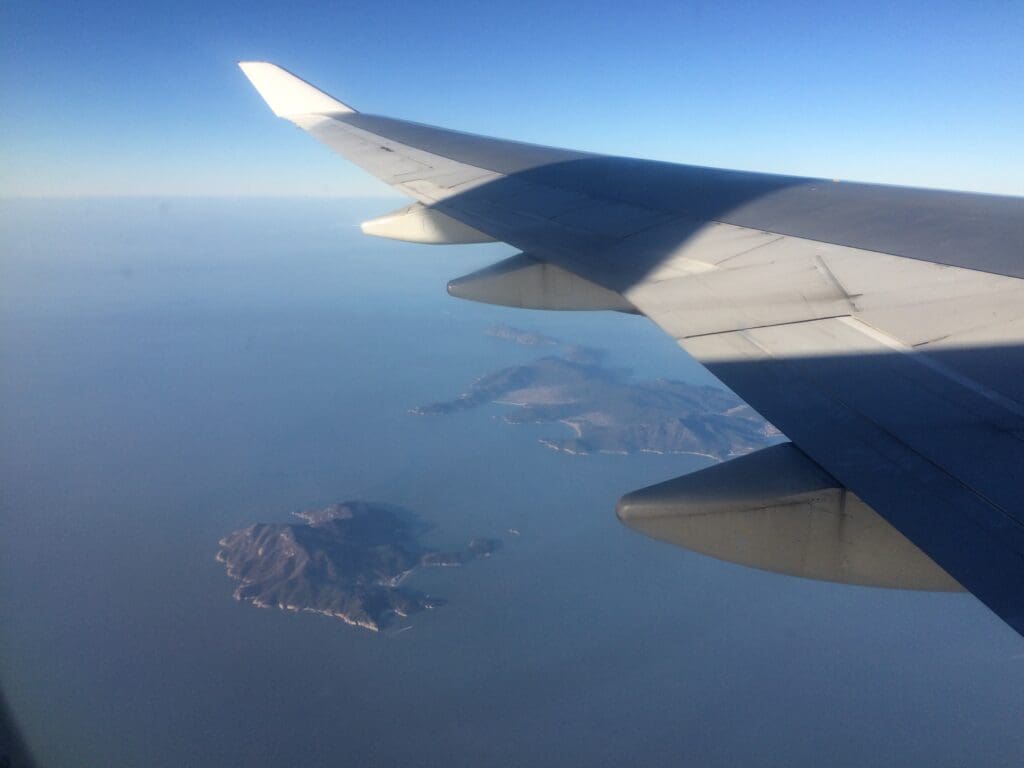
With around twenty minutes to go the second officer conducted a speech informing us of our remaining flight time and the ten minute taxi time that we could expect once on the ground. After overflying some of the islands off the coast of Incheon we turned onto finals for runway 34 and at 1611 the Boeing touched down on the same runway that I had left behind a week earlier on a Korean Air Airbus A380.. After an arrival speech from the cabin crew we pulled into the satellite terminal around forty minutes behind schedule, pulling in next to an Air China Boeing 737-800.
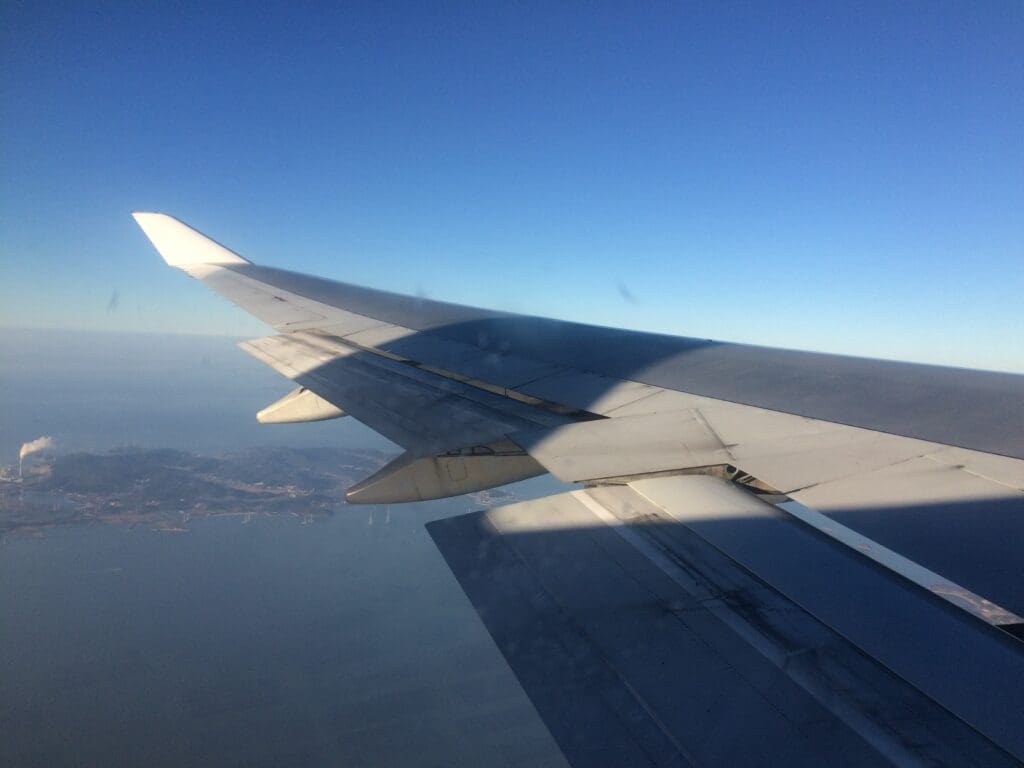

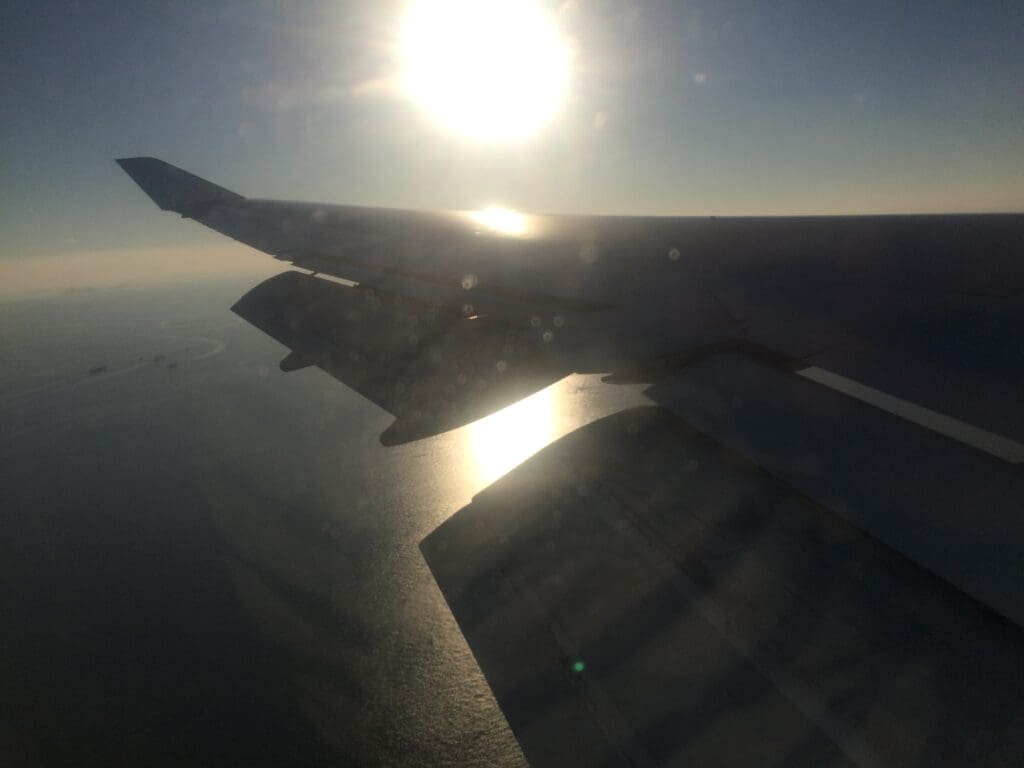

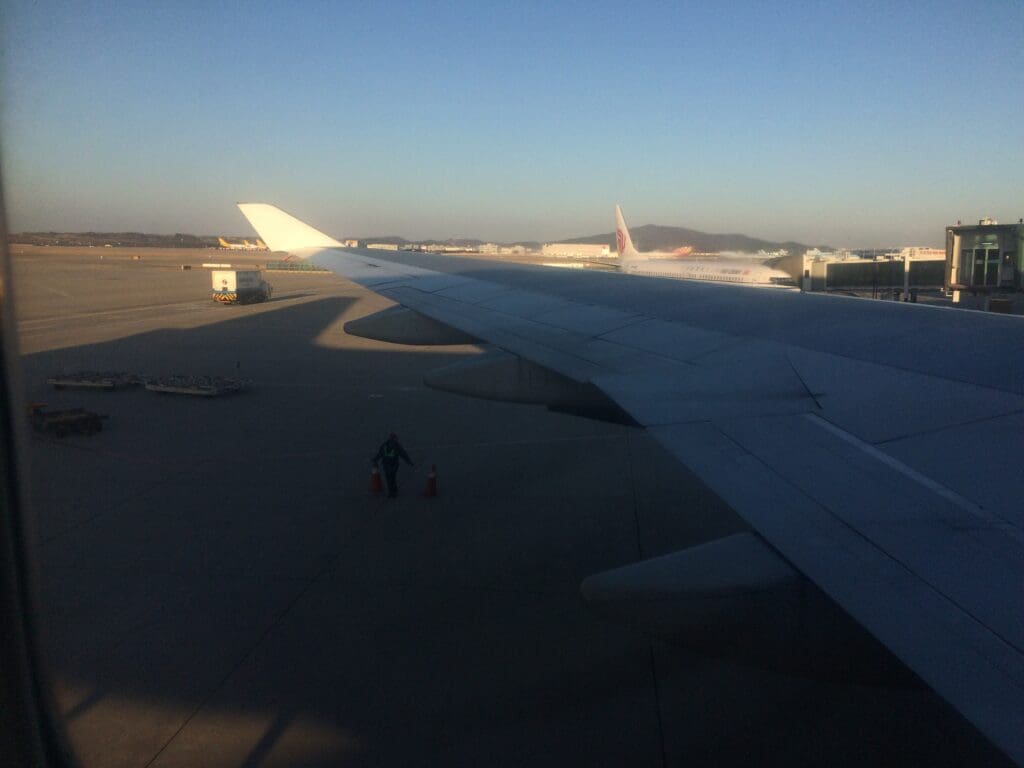
Disembarkation was fairly quick and I soon found myself speeding towards the main terminal. Immigration at Incheon can be hit and miss, usually I don’t have to wait for more than ten minutes although occasionally at crowded times it can take significantly longer. Having arrived during the European arrival rush hour period and at the same time as an Air Canada Boeing 787, I was a little concerned that it might take some time to clear immigration. Much to my surprise there was no queue at all and within twenty minutes of disembarkation I had passed through immigration, collected my bag and was heading towards the all-stop AREX train for my journey back to my little flat in Seoul.
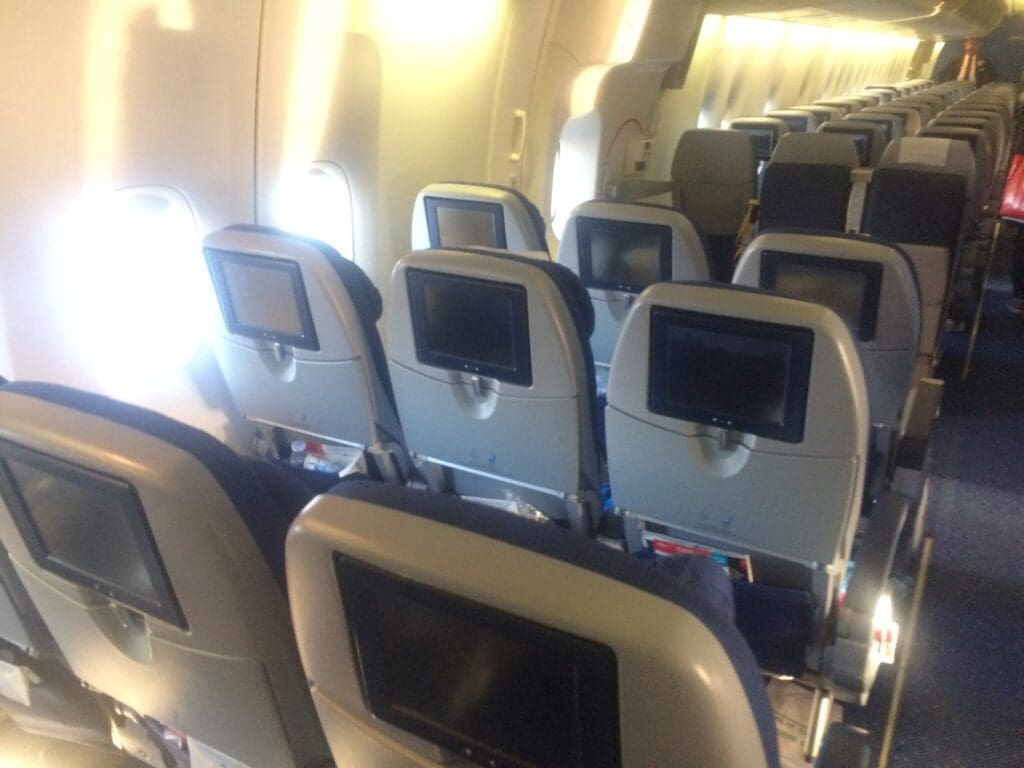

Conclusion
I could focus on the negatives of the long haul flight i.e. the tired looking cabin, the crashing inflight entertainment system or the leaky ceiling however instead I’ll focus on the positives. On both my flights, the KLM crew seemed to do their jobs well, they were professional, polite and unlike on many airlines they were not robotic. They seemed to be genuinely warm, friendly and very happy to be flying that day. The food was also pretty good too and so I have nothing to complain about here. Would I fly KLM again? Short haul within Europe – definitely, Long haul – probably but I’d probably want to fly in one of their newer or updated cabin aircraft.
